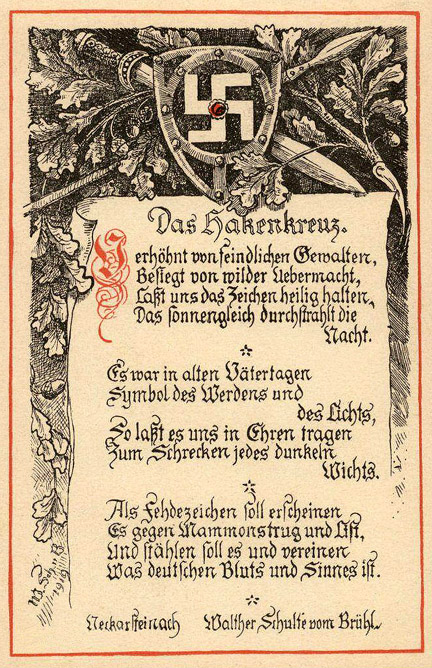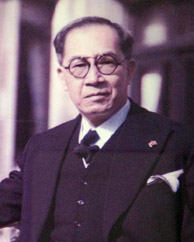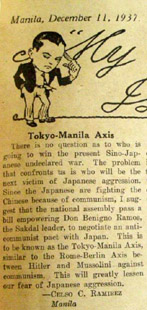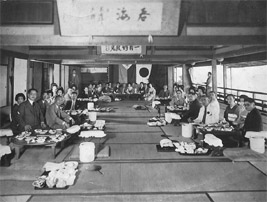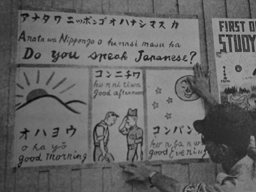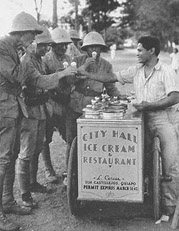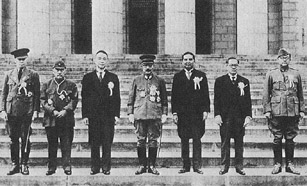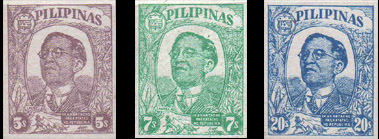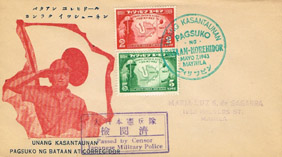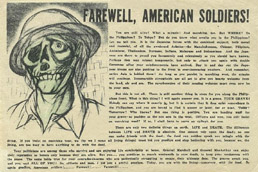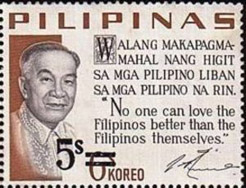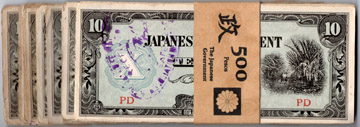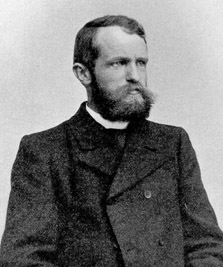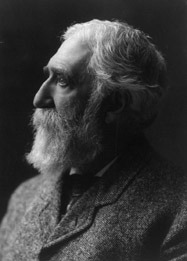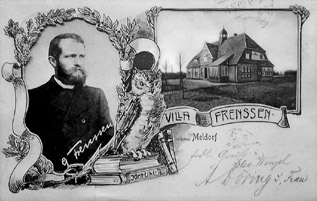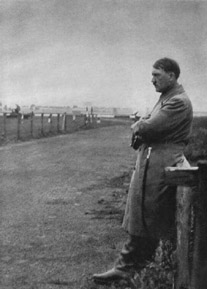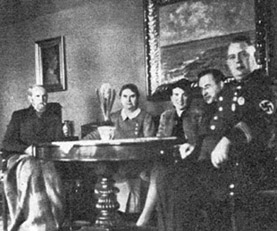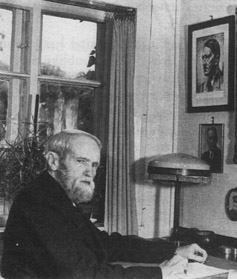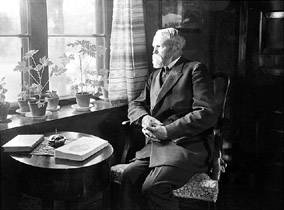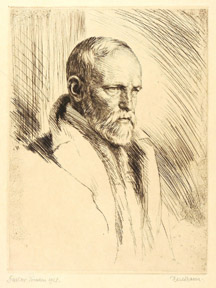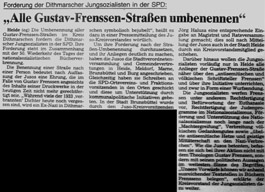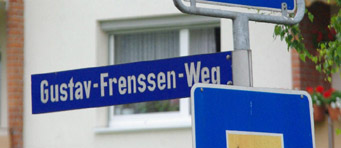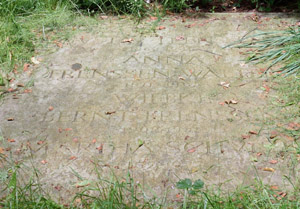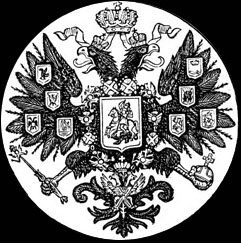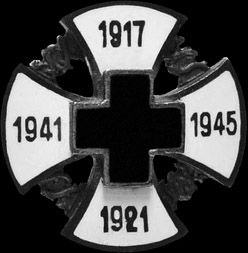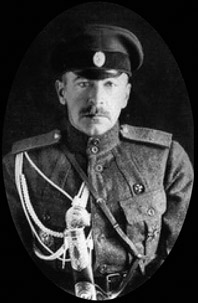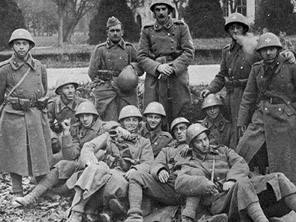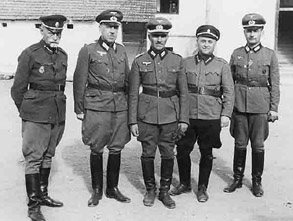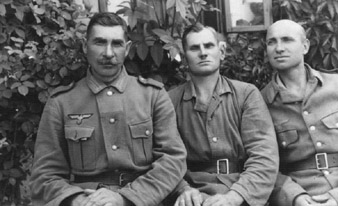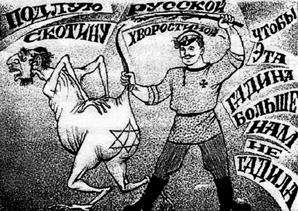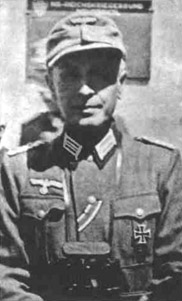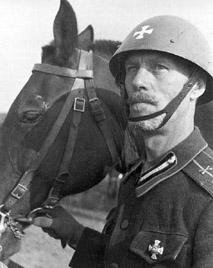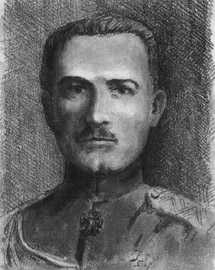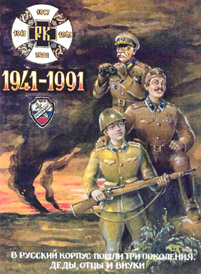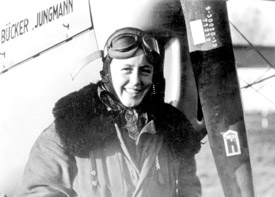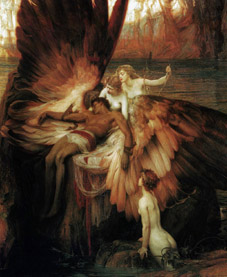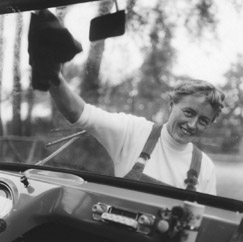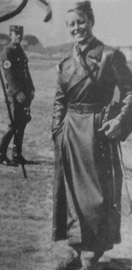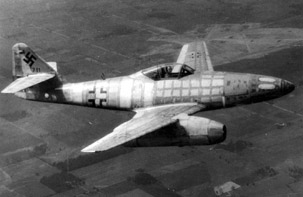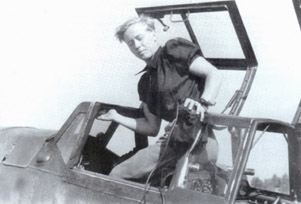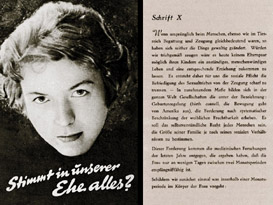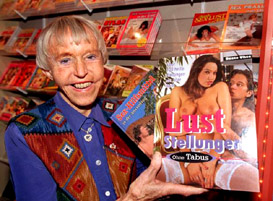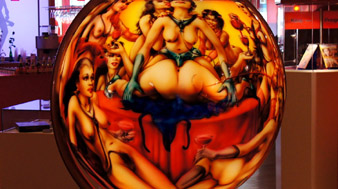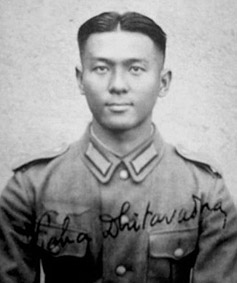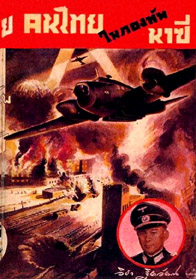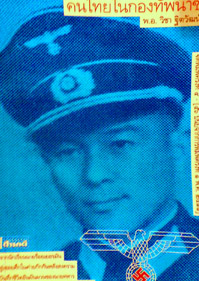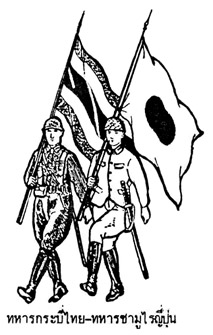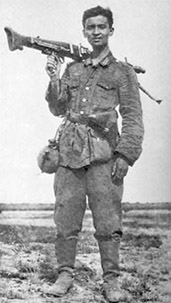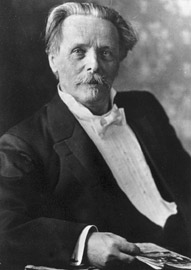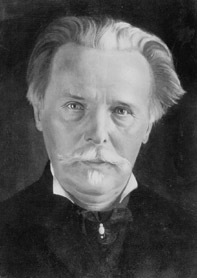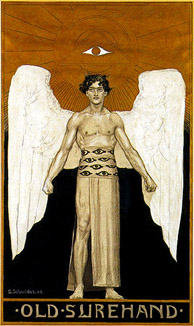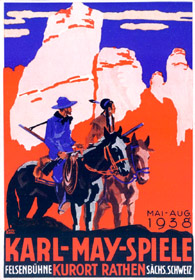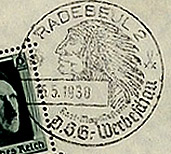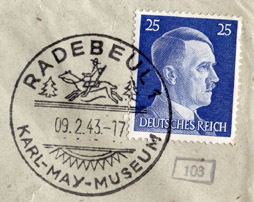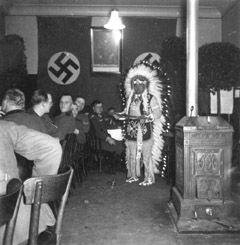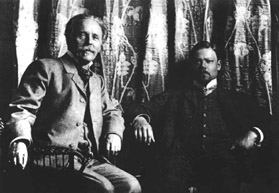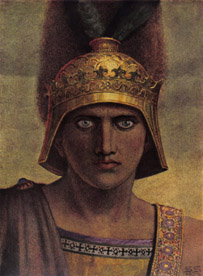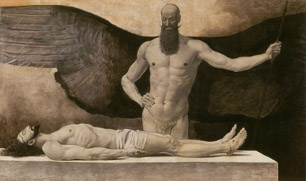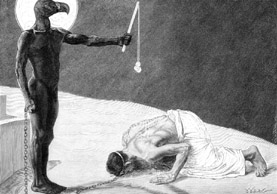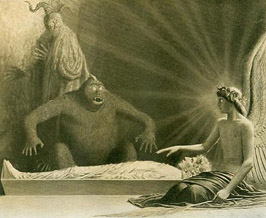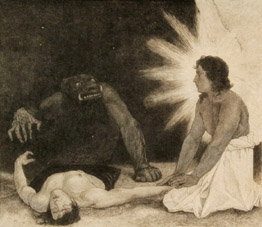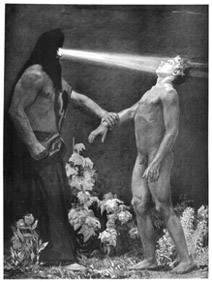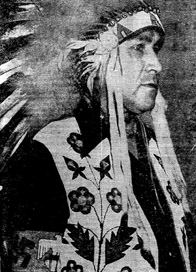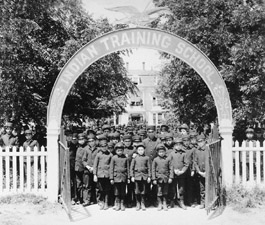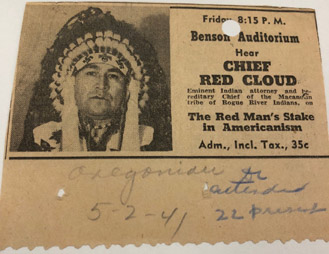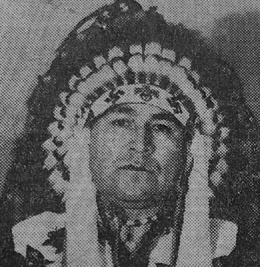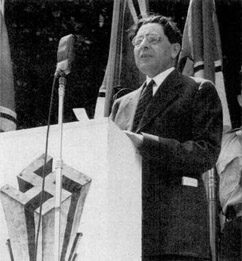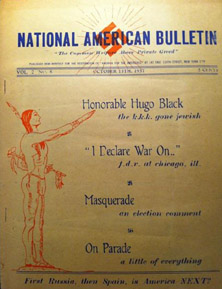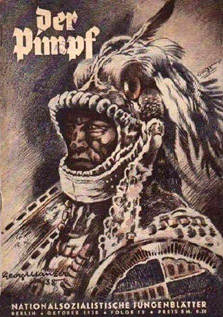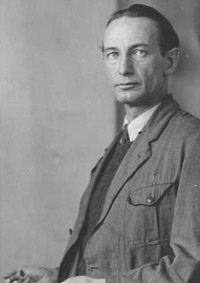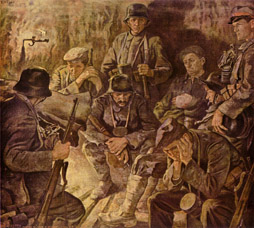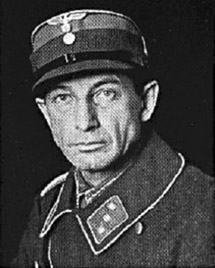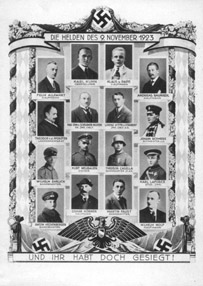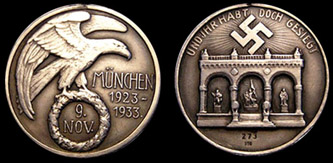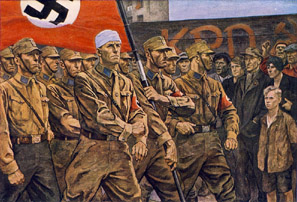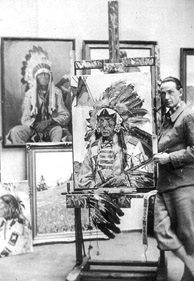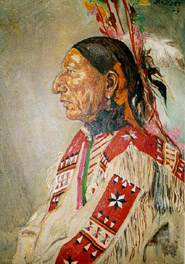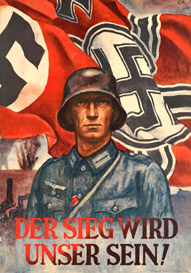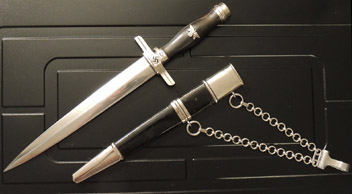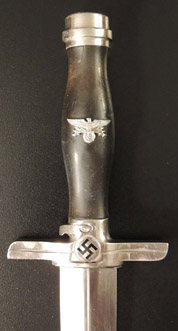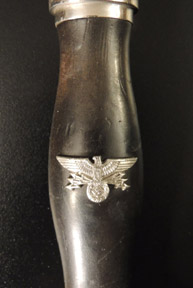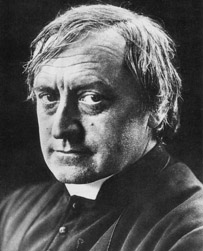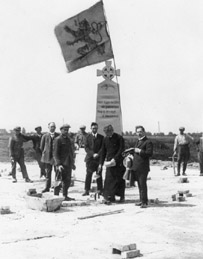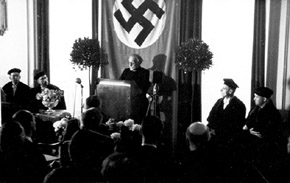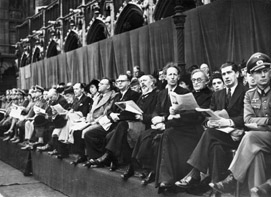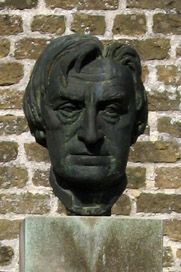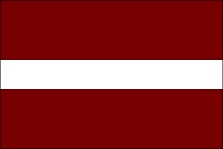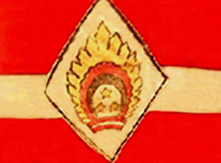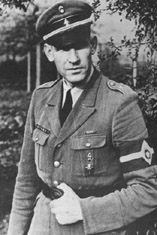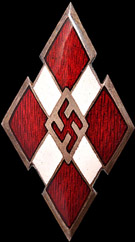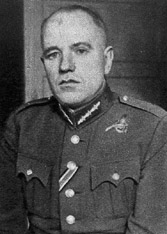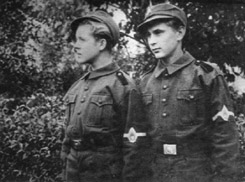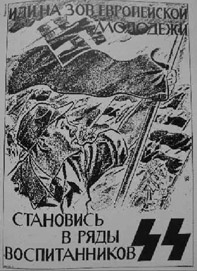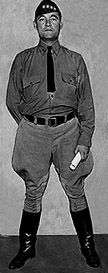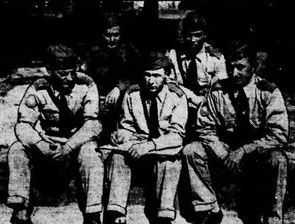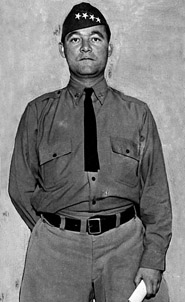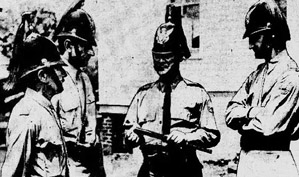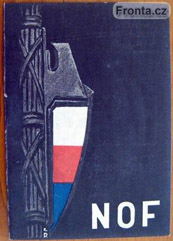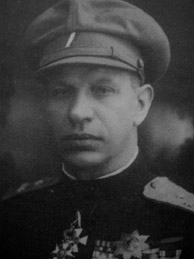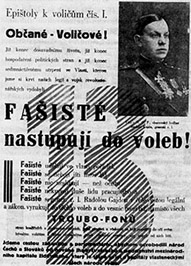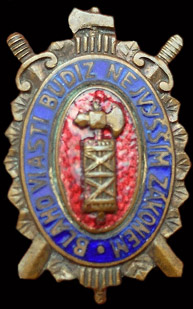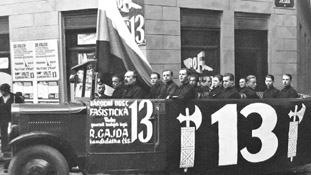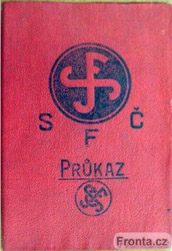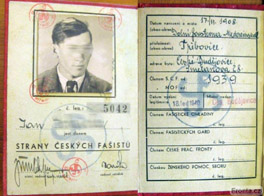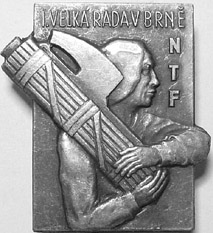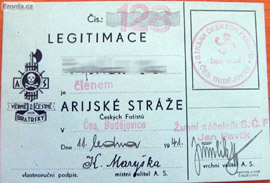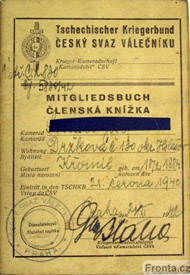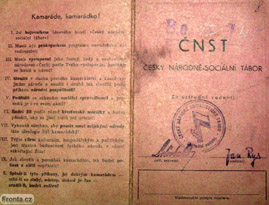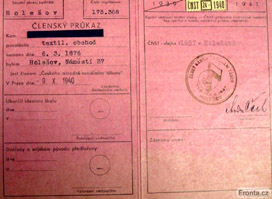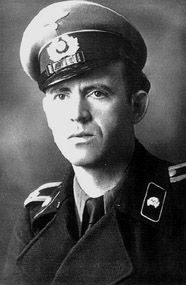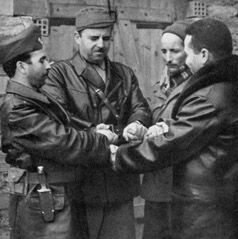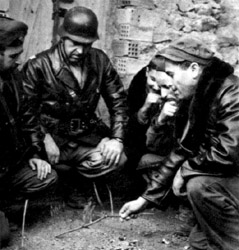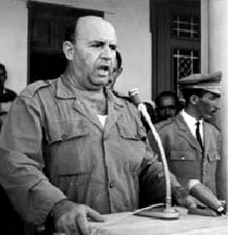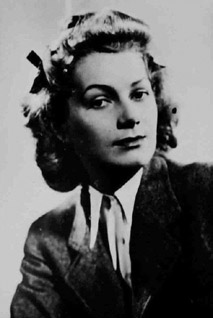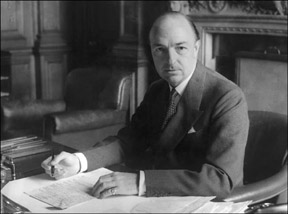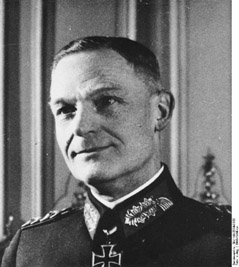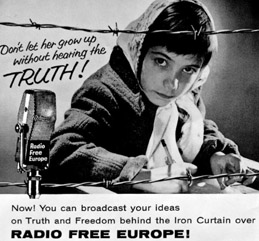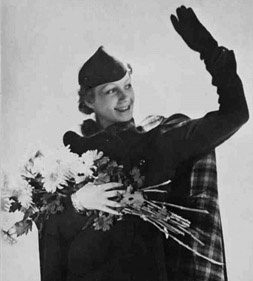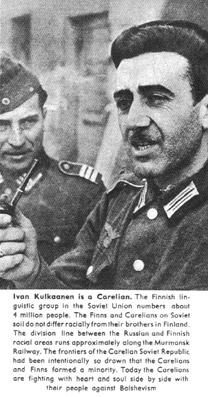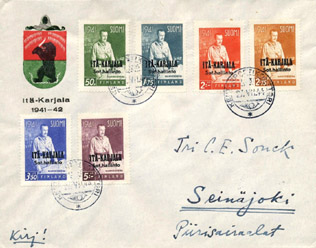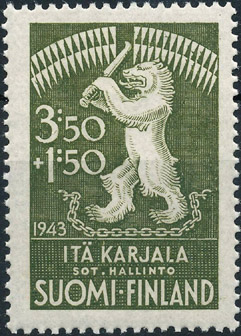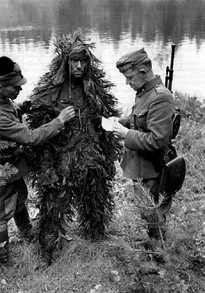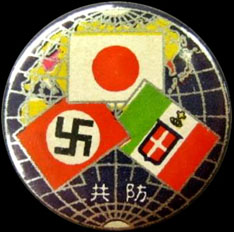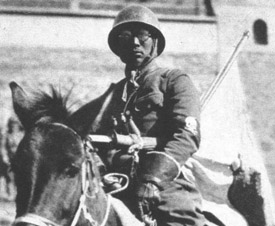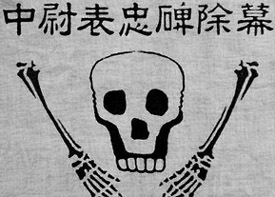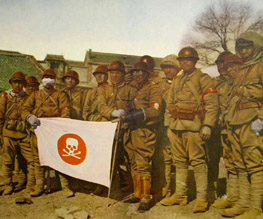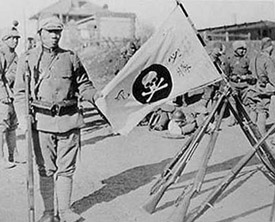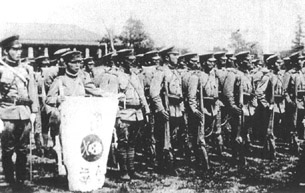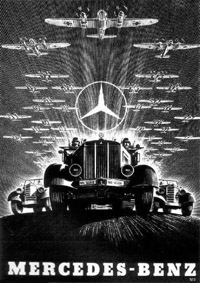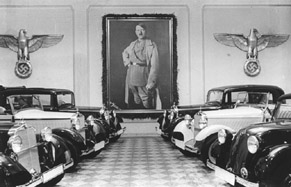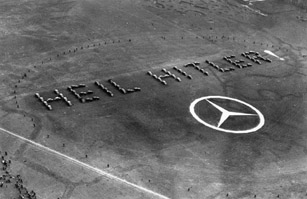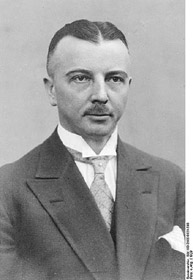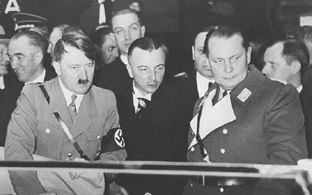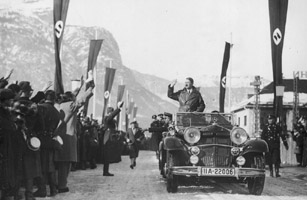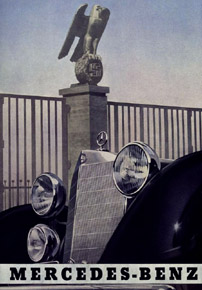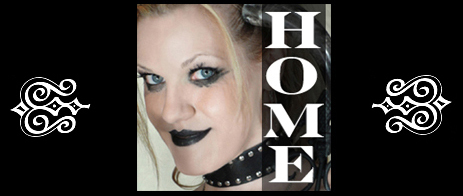
Page eighteen. 18. The minimum age in the USA for a person to go to war. Each additional page seems like a victory. It's never easy putting together the tattered fragments of history for the various listings, but it is very fulfilling when they are completed. The past deserves to be known. Especially when it involves men and women who fought and died for ideals we agree with. In my research for these pages I have run across the names and deeds of hundreds and hundreds of such individuals. Fellow human beings who have nearly been forgotten, but whose deeds yet glimmer in the darkness of a buried and hidden history. They are from many different locales on earth - jungles, deserts and cities glittering in the night - from every continent and race of this planet, but are united in their fight by an iron dream and invincible ideals. They are an army of mankind.
They are not dead. They speak to us. Their eyes stare back at us through the other side of history. They have entrusted to us the ageless dream. They faithfully hand us their weapons: truth, honor, courage and justice.
They refuse to die. They energize us and lend us strength when we are weak and give us light when the world grows too dark.
They are our faith. Their deeds are our religion. Our god speaks to us through our struggle.
May they blow the dust of history into the eyes of the blind. And thereby cause the whole world to see that our truth is the gospel of the free and the law of the strong. That our truth, the only truth, is the sole truth capable of setting the world finally free. Finally free from the aching chains that have bound us and driven us apart, and Adolf Hitler is the key.
[Above: 'Live True - Fight to the death - Die laughing!' Upper corner of German postcard, circa 1915]
The Swastika
-Postcard, 1919
*Special thanks to Gerhard Lauck for the translation!
[Above: José P. Laurel during his visit to Tokyo to attend the Greater East Asia Conference in 1943.]
• José Paciano Laurel y García (March 9, 1891 – November 6, 1959) was the Filipino president of the Second Philippine Republic (1943 - 1945) during the Japanese occupation and subsequent autonomy during WWII, before which he was a politician who held a myriad of posts and also a judge.
An interesting fact about Laurel is that he was indicted for attempted murder when he nearly killed a rival suitor of the girl he liked with a fan knife when he was a young man. After finishing law school he argued successfully for an acquittal. He received his law degree from the University of the Philippines College of Law in 1915. Later obtaining a Master of Law degree from the University of Santo Tomas in 1919. Not finished yet, he went on to attend Yale Law School and obtained a Doctorate of Law. Additionally he received an honorary doctorate from Tokyo University.
After returning from Yale he was appointed first as Undersecretary of the Interior Department, and later promoted as Secretary of the Interior in 1922. After clashes with the American Governor-General Leonard Wood he later resigned in protest of Wood's administration. This act of protest caused other Cabinet members to resign with him.
[Above: An interesting newspaper article from the Philippine Free Press, December 11, 1937. It shows us a glimpse of what was on the minds of Filipinos, the contemplation of a Tokyo-Manila Axis, like that of the Berlin-Rome Axis. The United States, who was occupying the Philippines at the time, however, would have crushed such an attempt.]
After Japan invaded the Philippines, which at the time was occupied by the United States, the leader Manuel L. Quezon fled to the United States to establish a government-in-exile. Quezon ordered Laurel and other cabinet members to stay.
[Above: Quezon secretly visited Japan from June 29 to July 10, 1938. He wished to know more about Japan's fight against China and their future plans.]
Laurel was amongst a handful of officials asked by the Japanese Imperial Army to form a provisional government after their successful liberation of the Philippines. Laurel cooperated with the Japanese and the National Assembly later selected him to serve as President in 1943.
[Above: Poster bearing the slogan, in Tagalog: 'One Banner, One Nation, One Language.']
[Above: Posters to teach Filipino people rudimentary Japanese.]
On June 5, 1943, while President Laurel was playing golf, an assassin attempted to murder him. He was shot four times with a .45 caliber pistol, the large caliber bullets barely missed his heart and liver. He was rushed to the hospital where Japan's best surgeon, the Chief Military Surgeon of the Japanese Military Administration, along with several Filipino surgeons, operated on him. He survived and quickly recovered.
Here's where the story gets interesting. Two suspects were captured and executed shortly after. A third suspect, a former boxer named Feliciano Lizardo, was brought to the hospital for identification to Laurel at his hospital bedside. Laurel professed he couldn't be sure if Lizardo was indeed one of the would-be assassins.
Shockingly, however, in his 1953 memoirs, Laurel revealed that Lizardo, who was by then one of his bodyguards and had pledged to give his life for him, was in fact the third would-be-assassin! Why he chose to show mercy on Lizardo is unknown.
[Above: A Filipino civilian gives ice cream to Japanese soldiers in Manila, 1942.]
On October 20, 1943 the Philippine-Japanese Treaty of Alliance was signed by the two countries. Shortly thereafter Laurel and his cabinet ministers flew to Tokyo and attended the historic
Greater East Asia Conference (an international summit held in Tokyo, Japan from November 5 – 6, 1943). The conference brought together various members of the Greater East Asia Co-Prosperity Sphere. It was the beginning of a unified Asia without colonialism.
[Above: Participants of the Greater East Asia Conference held in Tokyo, Japan, Nov 5-6, 1943.
Left to right Ba Maw (Burma), Zhang Jinghui (Manchukuo), Wang Jingwei (China), Hideki Tojo (Japan), Wan Waithayakon (Thailand), José P. Laurel (Philippines) and Subhas Chandra Bose (India).]
[Above: Postage stamps issued on October 14, 1944 in commemoration of the first anniversary of the Second Philippine Republic. Depicted on the stamps is President Laurel.]
[Above: A postcard from the Philippines dated May 7, 1943 celebrating the Japanese victories against American forces at Bataan and Corregidor.]
On September 21, 1944 martial law was declared in the Philippines. The next day war was declared on the United States and the United Kingdom.
[Above: 'Farewell, American Soldiers!' Japanese leaflet for American soldiers.]
After the inhuman atomic destruction of two of Japan's cities the dream of a united Asia died. Over 200,000 souls, rats as the Americans called them, snuffed out in the atomic flames. The Allies quickly closed in and reoccupied their colonies and scrambled for new land and possessions.
President José P. Laurel was arrested by order of the coward
Gen. Douglas MacArthur, who had previously fled the Philippines leaving his troops to an unknown fate. He was charged with collaborating with the Japanese. In 1946 he was charged with a comical 132 counts of treason, but he was never brought to trial due to a general amnesty in 1948.
Laurel remained active in politics and was popular with many Filipinos, despite the United States' attempt to taint him as a traitor.
[Above: 1960s postage stamp honoring Laurel. Click to see an envelope and coin.]
On November 6, 1959 Laurel died in Manila of a massive heart attack and a stroke. He is buried in Tanauan, Batangas. The years that followed saw monuments to Laurel, schools bearing his name, coins his likeness, postage stamps his face and on and on. The vengeful victors gave Asia a much broader leash when dealing with their Axis heroes. Such honors would never have been allowed in Germany or Europe in general.
[Above: Japanese occupation of the Philippines currency in rare bank bundle.]
• Click here to read the Inaugural Address of President Laurel, October 14, 1943
• Click here to see pictures of Japanese soldiers in the Philippines
• Click here to see leaflets and posters from the Japanese occupation of the Philippines
• Click here to see pictures of a 'Short Snorter' souvenir
• Click here to see pictures of 'guerrilla notes' used by American funded rebels in the Philippines
[Above: Gustav Frenssen.]
Gustav Frenssen was a very famous and most beloved author. He was also a fervent nationalist, pagan, and National Socialist. Yet, unfortunately not so strange, nearly forgotten in
today's world. Despite his massive popularity, despite the fact that he sold millions of copies of his books that were translated into many different languages, and despite that he was awarded
with heaps of accolades and awards, he is unknown to us today.
The ruling powers after WWII buried Frenssen's work. In the Soviet occupation zone and the Allied occupation zone (German Democratic Republic), his works were placed
on a list of books to be suppressed.
But let's go back, back before all of the darkness the victors of WWII brought upon the world, let's go back to Gustav Frenssen's time. Frenssen attended school in Schleswig-Holstein, in
the towns of Meldorf and Husum and later, in 1886, studied theology at the universities of Tübingen, Berlin and Kiel.
His first calling was from God. He sought answers through religion and in 1890 he thought that he had found his place in the universe: he was appointed pastor in the
village of Hennstedt and later in the village of Hemme. That same year he married Anna Walter.
But Gustav was a man of many callings. Perhaps his truest was his extraordinary ability at writing. In 1896 he published his first major work. Numerous books followed
and they were received so well that he resigned his pastoral office in 1902 and was able to live as a freelance writer.
The writer Charles Dudley Warner described Gustav best:
'Frenssen belonged to that group of Schleswig-Holsteiners who drew their real strength from the soil of their native district. Frenssen's stories are full of the sea
and the moor, and of the quiet reserved men and women who live half-isolated there, wresting a hard-won living from sea and shore. As he pictures them, they are hard,
bitterly earnest, and stubborn, yet they can be soft and mild. Born and brought up among them, and then working among them, this Holstein country person knows to the
backbone the people he tells us about, and sets them before his readers, a real world.'
His whole life changed in 1901 when he wrote a novel called 'Jörn Uhl'. It quickly became the most popular and widely read book in Germany, running into two hundred
editions!
Charles Dudley Warner described Jörn Uhl as:
'...the story of a strong, vigorous, straight, and simple man trying to hammer out some conception of God and of life that will work. And it is told with a remarkable
power of making the scenes and the people live before the reader's eyes.'
[Above: Charles Dudley Warner was a close friend of Mark Twain (Samuel Clemens), with whom in 1873 he co-authored the famous novel The Gilded Age: A Tale of Today. The
book satirizes greed and political corruption in post–Civil War America. Circa 1897.]
Charles Dudley Warner went on to describe the book:
'Its theme is the moral force that can be derived only from hard work,—and the healing, elevating influence of severe sustained effort. The story is simple. The Uhls
live on a large, pretentious farm, and consider themselves better than their neighbors. The father is easy-going and wasteful, and spoils his two oldest sons by
letting them swagger around without working, wheedling money out of him for their dissipations. Jörn, the youngest, is slow and rather stolid; he is the only one that
cares how things are going, and by and by is drafted into working like a hired man on the farm. The father is crippled by an accident just as a heavy mortgage falls
due, and the burden of retrieving the family fortunes falls on Jörn. He puts in years of bitter toil in the vain endeavor to build up the run-down farm—or rather the
run-down farm and family, for in 'Jörn Uhl,' as in 'Frau Sorge,' the family and the soil are the two elements out of which life is made. Frenssen, like Sudermann,
makes everything grow out of these two things. Jörn leads a life full of toil and despair; he has one misfortune after another, as long as he feels like the lord of
the manor. All his troubles, however, cannot break his Frisian peasant spirit, and at last he sees that he has made a mistake in trying to begin at the top, and that
he must begin over again at the bottom.'
In 1903 Frenssen was awarded the honorary doctorate of theology from the University of Heidelberg. His books continued to sell hundreds of thousands of copies just
months after their appearance. His works were translated into numerous languages and he was especially popular in Scandinavia. His books reached a monstrous total
circulation of around three million copies! In 1914 he was proposed for a literary Nobel Prize, but was 'mysteriously' not chosen. He attributed this to a 'Jewish
clique'. Hmmm... sounds familiar. Know of any other artists who were mysteriously passed over?
Throughout this time Frenssen was growing more and more political. As the darkness slowly eroded Germany and the world at large, his search for truth grew. In 1896
he became a member of the National Social Association, headed by Friedrich Naumann, remaining with the group until its dissolution in 1903. He was against the
falseness of Democracy, and longed for a strong authoritarian figure to lead Germany out of its ruin. Like so many other men of conscious, he despised the sickness of
the Weimar Republic.
[Above: Postcard of Frenssen.]
In 1902 Gustav moved to Meldorf until 1906 when he relocated to Blankenese. It wouldn't be until 1919 that he would move back to the place of his birth - his beloved
Barlt.
In the meantime, however, in 1905 he wrote the book 'Hilligenlei' (The Holy Land). Let's let Charles Dudley Warner describe it for us:
'[Hilligenlei] is a little village on the coast of the North Sea. The belief some of the villagers have, that their town is to be the true Holy Land out of which the
Savior will one day come to lead the world to higher things, runs all through the story, and finds its culmination in a sort of essay on the life of Jesus with which
the story closes. Kai Jans writes it as he is dying; Kai is one of the village lads who has grown up to see that far from being a holy land, Hilligenlei is full of
weaklings and fools—and human beings. The conception of Christ that Frenssen gives here is based on the beauty and greatness of true humanity; his Christ is a
beautiful human figure, full of love of truth, and with warm devotion to the needs of the meanest of men, who finds God as the father of love in the depths of his own
soul.'
Charles Dudley Warner further describes to us this complicated man:
'Frenssen is sometimes charged with too frank an acceptance of the physical side of life. What he really stands for, however, is that one must not be afraid of life:
"Feigheit vor des Lebens," fear of life, is to him the one irremediable mistake. Everything that is a part of life, of nature, must be met fearlessly and welcomed. The
Christianity he preaches is joyous, not penitential.'
During the 1920s Gustav revealed his hatred for the Jewish control of Germany. His books showed a longing for a purity and peace which was the antithesis of the Weimar
Republic. The roots of evil grew deep and the twisted canopy of the tree of darkness cast a shadow which engulfed the world. It seemed impossible. Hunger, crushing
poverty, riots and unrest, murder and crime were commonplace. While the rich, the bourgeoisie, celebrated in baths of wine and limitless wealth. But like Charles
Dudley Warner's novel The Gilded Age, their wealth was an illusion, and the people's will could not be bought.
The people cried for a savior. Frenssen waited... God answered their cries. From the impoverished gutters of Austria, from the stale boarding houses of the poor, from
the muddy trenches of the Great War, from the hopeless destitution of aimless wandering, he arrived.
With God in his eyes, aching truth on his lips, he brought forth the mana, the magic, the spiritual resurrection, the hope of all nations. Dreams fulfilled and a
promise of a new age. An age free from the sickening chains of usury. Free from the rotting cage of physical, mental and spiritual slavery.
Free.
FREE!
Adolf Hitler.
Free.
[Above: Freedom.]
Gustav's savior had finally arrived. In the coming elections he voted for Adolf Hitler and openly supported the NSDAP. In 1933 he signed a pledge of loyalty to Adolf
Hitler. Gustav Frenssen was energized and reinvigorated. Two Jews, Hans Sarkowicz and Alf Mentzer affirmed that the books written by Gustav after 1933 were 'almost
invariably [...] National Socialist propaganda'.
[Above: (from left to right) Gustav Frenssen and his wife Anna with Alma Rogge, Waldemar Augustiny and the SA group leader and the mayor of Bremen Johann Heinrich Böhmker, Spring 1938]
In October of the Year of Freedom, 1933, Frenssen was admitted to the Prussian Academy 'Deutsche Akademie der Dichtung' (German Academy of Poetry). The same year he
was awarded the Raven Prize. Five years later he received the coveted Goethe Medal for Art and Science. In 1939 he was appointed the honorary sponsor of the
Reichsverbands Deutscher Schriftsteller, a subdivision of the Reichsschrifttumkammer.
[Above: Gustav Frenssen in his study, Barlt, 1942. Note the picture of Adolf Hitler on the wall.]
An article published in 1947 by Frank Braun said that Frenssen had come to see Hitler as 'a second and greater Bismarck.'
Gustav was a member of the executive committee of the Eutiner Poet Circle, which was founded in 1936 and was one of the most important groups of authors in National
Socialist Germany.
1936 was a huge turning point for Frenssen. He published his book 'Die Glaube der Nordmark', where he turned away from the Christian religion and embraced a 'Nordic
neo-Buddhism'. He also rejected conservative sexual morality. Like many people of his day, he publically supported eugenics and euthanasia. He continued to write and
in 1938 he published 'The Way of Our People'. Into the 1940s he continued to publish books. His enemies say his books were ripe with 'anti-Semitism', 'anti-
intellectualism' and 'nationalism'. Oh my!
[Above: Gustav Frenssen in his study.]
In the final years of the war Frenssen worked for the radio and other NSDAP media outlets. His books were being printed in special editions for soldiers in the field.
His works continued to capture the public's imagination. The realism and incredible attention to detail drew millions of readers. But alas, the National Socialist sun
set. But only to rise again at a future time, brighter and stronger than ever before.
After Frenssen's death, which I was unable to research any details about, beyond the day he died (April 11, 1945), he fell into utter obscurity. The Allies were faced
with armies of artists, writers, poets, sculptors, scientists, musicians, etc., who were through-and-through National Socialists. Men who were leaders in their fields.
Men like the American Ezra Pound, who was named 'the Father of Modern Poetry'. The Norwegian Knut Hamsun, probably one of the greatest writers of the world. France's
Louis-Ferdinand Céline. Dr. Wernher von Braun. I could go on and on. The Allies were faced with the problem of all of these geniuses who were 'terrible Nazis'. What
could they do? Well, in the case of Pound and Hamsun they threw them in insane asylums! 'No problem here, they just experienced momentary insanity!' Others they
jailed, heavily censored, banned them from their professions, ostracized, or in the case of Gustav Frenssen they just buried him and tried to pretend that he never existed.
[Above: Gustav Frenssen by Karl Bauer.]
Gustav was charged with the unforgivable crime that 'he helped the National Socialists prepare the way [in] the beginning of the
thirties.'
And also 'the most evil anti-Semitic incitement and intellectual complicity in the Nazi crimes.'
In the Soviet occupied slice of East Germany, the 'German Democratic Republic', Frenssen's work was heavily censored and any 'anti-democratic' or 'anti-
Semitic' passages were removed. In the other occupied slice of Germany, the western 'Federal Republic of Germany', Frenssen was 'charged' with
'[having] a great complicity in the crimes committed against the Jews during National Socialism by his public party campaign against "Jews and Jewish Artists" before
and during the Nazi era.'
During the years of National Socialism many streets were named after Frenssen, especially in his home old home of
Schleswig-Holstein.
The vengeful apes who rule Germany with an iron fist today could not have this. In September 1983 they began their mission to remove all of the street signs in Germany. They claimed that Frenssen was a monster. No, worse than a monster - A Nazi lover!
[Above: A DLZ newspaper article on the matter - in Deutsch! Click to read another. Circa 1984]
In fact, these evil tyrants claimed to have collected
'several thousand pages' of evidence which proved this!
Shockingly, the city board declined to take down the street signs, saying:
'Gustav Frenssen cannot be regarded as a pioneer of national socialism in the critical appraisal of his writings.'
They also said that despite the picture of Frenssen in his study with a picture of Adolf Hitler on the wall (scandalous!), and his
'thoughts on the destruction of inhospitable life and Judaism, [that] the reputation of the homeland poet in the population justifies the naming of a street by name.'
Additionally a local chairman Berndt Steincke is quoted as saying:
'Frenssen was mostly a native poet, and his contemporaries have characterized him as a selfless and warm-hearted man who always had an open ear for the worries of
others.'
[Above: Evil street sign. Click to see more!]
However other places in Germany bearing Frenssen's name were not so lucky, such as 'Frensufufer' in Groß-Buchholz. Residents one day received a letter stating that
their address was going to change. The address that they had lived under for decades and decades. A resident, Helga Metz, lamented the childish decision to change the
street name:
'We have lived with the name. It would have been easier to leave. Now we have to change all addresses here, driving license, bank,
everything.'
And that was not all. In 1983, his name was removed from street signs in Heide (Holstein) and in 1986 in Hamburg-Blankenese. In 2011 Frenssenstraße, which had been
named after him since 1920, in Kiel-Pries was renamed with the reason that Frenssen had 'put his talents knowingly and willingly into the service
of the National Socialists.'
More and more streets followed in their attempt to erase Frenssen. In 2014 the Gustav-Frenssen-Straßen in Heide, with Brunsbattel following. The next year, in 2015, in
Marne and Meldorf.
But due to Frenssen's 'Hitler veneration' the Enemy wishes to wipe all trace of him from the earth. Such is their way. But we remember you, Gustav Frenssen. Yes we
have not forgotten you. We wipe the ashes of war from your solemn beautiful face, and my hand, wet with a tear, brushes away the graffiti from your name. H E I L
Gustav Frenssen!
Writings:
Jörn Uhl (1901)
Gustav Frenssen's grave is located in Wodansberg near Windbergen.
[Above: Gustav Frenssen's grave on Woden's Mountain]
[Above: Badge of the Russian-Corps.]
During the Soviet Belgrade Offensive in late 1944 the Russian Corps fought the communist juggernaut in violent battles. They later withdrew to Bosnia and Slovenia when the Germans withdrew from the Balkans.
Lieutenant-General Boris Shteifon was tragically killed in April 1945 and was replaced by Colonel Anatoly Rogozhin.
But let's go back a few dark decades to an even darker time for the men of the Russian Corps. Back to the aftermath of the communist coup of Russia. Approximately 15,000 White Russian émigrés were forced to flee their homes and lands or face certain death by the communist murder machine.
When the Germans invaded the Soviet Union on June 22, 1941 the Russians in exile knew that their chance to free mother Russia had come. The Russian Corps were formed from this tight knit band of White Russian émigrés and officers of the Russian Imperial Army. Many of these men had fought the communists in a losing battle during the communist coup of 1917. They prayed that their time of redemption was at hand.
But their times of troubles were not over. Not by far. In the summer of 1941, during a communist uprising in Serbia, communist terrorists murdered approximately 300 Russian emigrants and injured scores more. These commies saw the White Russians as their mortal enemies, and vice-versa. Like all acts of communism, these murderers committed terrible atrocities against unarmed civilians. To meet this threat the Russians organized into self-defense groups.
Thus the Russian Corps were born.
[Above: Boris Shteifon. Click to see more!]
After the collapse of the Russian front in WWI Shteifon and his men went into exile in Eastern Europe, eventually ending up in Yugoslavia. During the 1920s and 1930s, he wrote several military tactical and historical works and became a professor of military sciences. But all the while he longed for Mother Russia's liberation...
After only a month Skorodumov grew ill and was replaced by his chief of staff Lieutenant-General Boris Shteifon. Initially the Russian Corps was called the 'Independent Russian Corps' and later changed to 'Russian Defense Corps' in October 1941.
[Above: Men of the Russian Corps]
Initially its goal was to raise a fighting force of 3,000, organized into three regiments. By late 1941, after only a few months of existence, it already had 1,500 members. Recruitment was done by a White Russian émigré named Major General Kreyter. Kreyter was already in German service, serving as the head of the Russian Intelligence Office in Serbia.
The initial 1,500 men were formed in a regiment, organized into four battalions. The 1st Battalion was commanded by Major General Egorov, the 2nd Battalion by Colonel Shatilov, the third by Colonel Endrzheevskiy and the 4th by Colonel Nestrenko. By October 18 a 2nd regiment was formed and commanded by Colonel Zhukov.
Men of the Russian Corps wore the uniform of the Russian Imperial Army from September 12, 1941 until November 30, 1942. Sometimes pips from the Royal Yugoslav Army were worn alongside special rank insignia on the collar. On December 1, 1942 Wehrmacht uniforms were issued to the men, but the old uniforms were still in use for some time after.
The Russian Corps ultimate goal from the beginning was to accompany the German and Axis forces into Russia and to help liberate it. After all, they had been dreaming of freedom and maybe revenge for over two decades by then. Unfortunately things didn't turn out that way. The Russian Corps were instead bogged down in Serbia fighting the murderous communists. Eventually they were given access to Russian prisoner-of-war camps and recruited their fellow countrymen to the cause. By this time it had grown to be one cavalry regiment and four infantry regiments. The Germans helped arm them with whatever weapons and gear they could get their hands on, such as weapons captured from the Royal Yugoslav Army and captured Soviet weapons.
[Above: German officers with men from the Russian Corps]
Communist Russia increasingly supplied their murderous 'partisan' (terrorist) armies with men and matériel. These terrorists engaged in all manner of nefarious work -- assassinations, murdering of civilians, arson and every manner of sabotage. All authorized and funded by Soviet Russia. Between the autumn of 1941 and the spring of 1944, men of the Russian Corps helped protect weapons factories, mines, roads, and railroads all over Serbia. During this period they were called 'Russian Factory Protection Group'. They successfully performed vital functions that helped the war effort. Such as on December 8, 1941 they successfully defended the Stolice mine against the communist forces.
By 1942 the Russian Corps swelled in numbers due to a large influx of volunteers from Romania, Croatia, Greece and Bulgaria. The corps often worked successfully with a variety of Serbian forces, such as the Serbian State Guard (SDS), the Serbian Volunteer Corps (SDK), the Croatian Ustaše and even Chetniks.
December 1, 1942 was an important day for the Russian Corps. They were incorporated into the Wehrmacht and its members swore an oath to Adolf Hitler. Eight days later, on December 9, 1942, the 1st Regiment absorbed a large number of Kuban Cossacks led by Major General Naumenko. In fact, there were so many Cossack volunteers that by January 1943, it was fully composed of Cossacks.
On March 17, 1943 Shapilov was replaced by Major General Gontarev as commander of the 3rd Regiment. Things were heating up for the corps by this time. The 1st Regiment fought in Loznica in April and took part in a large operation in Zapolje on May 11–15. During this operation the Corps engaged in violent combat with communist forces. On July 1-8 of the same year they successfully defended the strategic Drina bridge at Zvornik while stationed in Loznica and Ljubovija.
[Above: Russian Corps men in German uniforms]
They were fast earning the respect of their German and Axis comrades. In the summer of 1943 the Corps aided 379 wounded Croatian soldiers and civilians to reach safety. They also helped another 1,000 Croatian soldiers with many refugees reach safety, all while two of their own perished and another seventeen were wounded. Their bravery was beyond question.
In 1944 the Corps found themselves fighting an ever growing communist partisan threat. These spineless terrorists were growing bolder, better equipped and increasing in number. In March 1944 the Corps was victorious over a large communist force of 2,400 men.
The summer was shaping up to be a bloody one, and it would only grow worse. The Corps however had a job to do, and do that job they did. In the summer of 1944 they even mediated a peace agreement between the Chetniks and the Germans. The agreement unified the two, and the Germans and the Chetniks agreed to fight the invading communist partisans side by side.
By September 1944 the Corps reached its peak membership of 11,197 volunteers. September proved to be the most active, bloody and deadly month yet. Skirmishes and battles took place nearly every day for the Corps. They suffered over 50 casualties of dead and wounded every day!
[Above: A White Russian/Russian Corps man takes a switch to a subversive character.]
[Above: Anatoli Rogozhin in German uniform. Note his Iron Cross First Class and ribbon signifying Iron Cross Second Class. Click to see more!]
In June 1918, Rogozhin was a part of the Terek Cossack rebellion against the Bolsheviks, where after he became a part of the White movement. Like all patriots who had the means, Rogozhin went into exile in Yugoslovia.
After the war Rogozhin did not abandon his men, instead he became their commander in the refugee camp. He helped organize the evacuation of his former comrades and was one of the last men to leave the prison camp in 1951. His fight did not end there. After relocating to the United States he founded the Russian Corps Combatants veterans organization and established the Nashi Vesti (Our News) periodical magazine.
While in the United States Rogozhin continued to be active in White émigré organizations. He died on April 6, 1972 and is buried in the Novo Deveevo Russian Orthodox convent in Nanuet, New York by a chapel dedicated to the Corps.
[Above: A Russian Corps Calvary officer.]
In January 1945, men of the Corps took part in the German capture of Travnik, during Operation Lawine. April 30, 1945 was a terrible day for mankind. The day Adolf Hitler left us in body, the Corps Lieutenant-General Boris Shteifon left with him. Shteifon, who suffered from liver disease, died of a heart attack much to the sorrow of his men. He was buried in Ljubljana, Slovenia, at a German military cemetery (block VIII, row 6, grave 16).
[Above: Charcoal sketch of Boris Shteifon.]
Colonel Anatoly Rogozhin took over as commander of the Corps. Rogozhin led his battered men into British captivity on May 12, 1945 near Klagenfurt, Austria. The men numbered 3,500-5,584 tired souls. 6,709 men were either killed, wounded or missing from 1941-1945. All in all 17,090 brave men had served in the Russian Corps during the war. They had lost, again. The communist monster would claim the lives of tens of millions of innocent human beings in the coming years. The men of the Russian Corps had fought with their all, and had nothing left to give.
The men of the Russian Corps were lucky. Unlike so many others, the Allies didn't turn them over to the murderous communists. They were even allowed to resettle in the West after the war, some even finding their way to the Americas.
[Above: A postwar graphic from 1991 showing three generations of Russian Corps -- grandfathers, fathers and grandsons. Click to see more!]
[Above: Beate Uhse-Rotermund in Luftwaffe flight uniform. Click to see more!]
She was born in East Prussia, the youngest of three children. Her father was a farmer and her mother was a doctor, in fact, one of the first three female doctors in German history! So obviously being a pioneer was in her blood, as was breaking molds.
We're told that when she was eight years old her brother told to her the tale of Icarus. The young Beate loved the story and set out to try it on her own. With chicken feathers and glue she made a pair of wings and jumped from her porch... her spirit soared and Icarus no doubt smiled from high.
Her parents encouraged her dreams and interests, and her mother's profession no doubt contributed to the children being taught sex education early. Sex was not something dirty in their household and things like contraception and sexuality were discussed openly. This openness would influence Beate immensely later in life. But for now... the sky awaited her.
As a teenager she spent a year in England where she worked as an au pair ('a domestic assistant from a foreign country working for, and living as part of, a host family') where she learned English. Sometime after her return her father met a lecturer on motor sports from the German Aero-Club. Beate's father told the man, Mr. Sachsenberg, about his 'flying-crazy' daughter and the insane idea of a female pilot. Sachsenberg, however, was enamored by the idea and sent Beate, who was 17 at the time, information about flying and how to obtain a pilot's license. Sometime also during this time Beate was a member of the Hitler Youth.
[Above: The Lament for Icarus by H. J. Draper.]
At 17 years old she enrolled in a pilot school, being the only female in a class of 60. One year later, on her 18th birthday, she received her pilot's license! In 1937 she joined the Rangsdorf pilot school near Berlin. A year passed and Beate passed the stunt pilot exam and competed in a race in Belgium. She won! In other competitions she did well also, winning 2nd place overall in target landing and 3rd place in punctual flight.
At age nineteen she got a job with the Bücker aircraft company as a test pilot and later she worked as a delivery pilot for the Friedrich aircraft factory. After this she worked for the famous UFA film company to work as a stunt double in films.
[Above: Beate Uhse-Rotermund.]
[Above: Beate Uhse-Rotermund in leather Luftwaffe overcoat.]
But not all was work and no play. She fell in love with Hans-Jürgen Uhse, her stunt-piloting instructor. Hans wanted to marry her, and proposed many times, but she declined saying she would 'never ever give up flying for a man.' But eventually love had its way and she agreed to marry him. They planned for October 10, 1939, but the war got in the way and it was cancelled. On September 28, Hans-Jürgen Uhse was to serve his country as an airman. Nonetheless, they married in a small ceremony four hours before his departure.
Beate would soon follow him, joining the Luftwaffe, flying in an aircraft ferry unit. In the Luftwaffe she got to pilot many planes she could only dream of before, including Germany's newest marvel, the Messerschmitt Me 262 jet! Her unit was attacked many times, but she bravely continued on, as millions of her countrymen did also.
[Above: The Messerschmitt Me 262 jet - the world's first operational jet aircraft. Beate was trained on the Me 262 marvel on April 30, 1945, a mere week before the end of the war.]
In 1943 she became a mother and her son Klaus was born. Because her work was deemed vital to the war a nanny was hired by the government to take care of her new son.
In the fall of 1944, in October, Beate was made a captain and was in charge of the Überführungsgeschwader 1 (Ferry Squadron 1) based in Berlin-Staaken. She and her squadron delivered aircraft from factories to the front. She made over 1,000 flights in Messerschmitt 109s!
Meanwhile her husband led a squadron of Messerschmitt 109 fighters in the defense of Berlin. In the dark, horrible fires of 1945 death rose to claim another victim: her beloved husband Hans-Jürgen died in a crash, leaving Beate a 24-year-old widow with a one year-old son. He died one dark night while speeding down the runway and collided with a comrade's plane. He died instantly in the explosion. Beate was devastated. Her love for him would remain until the end of her life, and in interviews before her death her voice cracked while speaking of him.
As the communist monster encircled Berlin on April 22, 1945 Beate's squadron was ordered further west. She rushed through the destroyed city to her home in Rangsdorf and picked up her son and his nanny. The three made their way through the smoke and fire to the airport... but her unit had already left, along with her ride.
[Above: Beate Uhse-Rotermund with her Bf 109.]
But she wouldn't lie down and die. She found a small airplane, a twin-engine Siebel Fh 104 and while it was fueling up she hurriedly studied the plane's manual, as she had never flown this model before. The plane couldn't fit many, being as small as it was, but she managed to pack in two soldiers injured in the Battle of Berlin, her Luftwaffe mechanic, her two-year-old son and his nanny. She gunned the engines, dodging shell craters and destroyed aircraft and took to the smoky sky. Bullets ricocheted off the undercarriage of the airplane as the plane ascended. With doomed Berlin behind her, she flew north-west, reportedly hers was the last plane to escape from Berlin's Gatow airstrip in 1945.
She flew toward Schleswig-Holstein on the Danish border, eventually landing in a field near Flensburg. She later surrendered to British troops.
After some time in captivity she was released and settled in Flensburg with her son. The Allies made it so that many Germans could no longer practice their professions, and in Beate's case she was banned from flying. The girl who dreamed of flying since she was 8, jumping off roofs with wings made of chicken feathers, grounded by tyrants who had burned down her country and raped and murdered her people.
But life goes on. Beate was a war widow with a young son, flying had been her life, how would she provide for herself and her son now? For a while she made money in the black market, skirting the Allies' harsh rules in postwar Germany. She sold products door-to-door and made lots of acquaintances and new friends. There were many, many war widows like her, but also many destitute soldiers returning home from Allied concentration camps. Many babies were being born as a result. Infants amidst the rubble, with parents who could barely feed themselves. Many women, millions actually, had abortions in post-war Germany, but most of the initial abortions were from rape by Allied soldiers. But the abortions continued and many women used untrained individuals to carry out the procedure, or they attempted it themselves.
Beate remembered her early education from her mother on sexuality. Although her mother had died during the war, her lectures remained strong in her daughter's mind. Wanting to help her fellow women, she searched out further information on contraception methods and had a brochure printed. Having no money, she traded butter ration coupons with the printer. The pamphlet explained to the women about their fertility cycles and their infertile days.
[Above: One of Beate's pamphlets.]
By 1947 she was selling the pamphlet through her own mail order company. She quickly sold 32,000 copies before expanding into cities like Bremen and Hamburg. The pamphlet contained her mailing address and many women wrote her asking for advice on not only contraception, but also sex in general. She found many women to be totally in the dark about the topic. She later wrote in her autobiography 'These people were unaware of the facts of life'.
In 1951 she founded her company 'Beate Uhse Mail Order' with four employees. It took off. Two years later she had fourteen employees. Meanwhile, in her private life things were changing as well. She married retailer Ernst-Walter Rotermund and had her second son Ulrich.
[Above: The company bearing her name 'Beate Uhse' in Nürnberg.]
Here's where things get controversial: In 1961, in the town of Flensburg, she opened a specialty store geared toward sex and marital aids. The world's first sex shop. She also had a catalog which sold the same articles, everything from condoms to sex toys. She would later in 1999 be given 'honorary citizenship' in Flensburg.
She made many enemies and the police acted against her scores of times saying that the items for sale inside her store 'inflame and satisfy lustful desires in a manner contrary to decency and morality.' By 1992 she had been indicted more than 2,000 times!
[Above: Beate with one of her wares.]
Numerous people and organizations treated her like a black sheep. They refused to serve her, blacklisted her and refused her admittance at various clubs and organizations. She divorced her second husband in 1979 and in 1983 she was diagnosed with stomach cancer. She beat the cancer. At age 75 she reached another milestone: she got her first driver's license!
[Above: Beate Uhse advertisement.]
In 1996 she opened the Beate Uhse Erotic Museum in Berlin (which has since closed), a long-time dream. Five years later, in 2001, she died of pneumonia in a hospital in St. Gallen, Switzerland.
Beate no doubt contributed to the decadence of the modern age. A mixture of the want of money and her being banned from flying were big reasons for this, but not the only reasons. Society was being molded by the victors of WWII. Things that were once looked down upon were now being put on pedestals.
[Above: Inside the Beate Uhse Erotic Museum in Berlin. Click to see more.]
While I don't subscribe to a strict 'puritanical' view of sexuality, the proliferation of explicit pornography, unnatural fetishisms, and a wholesale lack of morals has forged a depraved world culture. In the West such things as divorce have become more a norm than marriage. Most relationships do not work. Unnatural selection has given the weak breeding rights, while many of the strong are left with the scraps, or none at all. By putting money on a pedestal many weak, mentally, physically and spiritually diseased people have been guaranteed breeding rights with genes of their choice. It's a terrible truth that many of our best aren't breeding. But as long as they are fighting, and are married to their beliefs then the hammer of nature will eventually equalize this imbalance.
[Above: Beate Uhse, the company, boasts millions of customers in five European countries. Their annual sales exceeds 100 million Euros, with over 65% coming from online sales. Beate Uhse AG is Germany's largest porn company, estimated to be worth 175 million pounds. It is also estimated that 98% of German's know the name Beate Uhse. It has shops in Holland, e-commerce in Australia, and is expanding to Poland and Britain, among others. ]
[Above: Wicha Thitawat (1917-1977)]
In 1938 Thitawat travelled to Belgium to study military communications. After Germany's occupation of Belgium two years later he continued his studies at a German military academy in Berlin. He was enthusiastic for Germany's victory and anxious to work with his German comrades. After graduation he was awarded the rank of captain (radio operator) and he promptly joined the Wehrmacht. He was fluent in French, which no doubt helped him in the years to come. Initially he was integrated into a German Panzer division, but was also recognized by the Thai embassy in Berlin as a military attaché. This was an unusual occurrence and showed the close trust and cooperation between the two countries.
[Above: Early edition of 'Khon Thay nay kong thap nasi' by Wicha Thitawat]
Thitawat was not unique however, there were other young Thai people who joined the German Wehrmacht (and eventually the Waffen-SS). These young men, like so many millions of other non-Germans in WWII, were ecstatic at the thought of an Axis victory. It was more than just a hatred of the colonialists for the young Thai volunteers, it was a brotherhood of shared dreams and ideals. A new world awaited them, but they'd have to fight for it first.
After the war Thitawat was captured by the Americans and imprisoned for a year. In 1947 he travelled back to his home country of Thailand. He continued his military career there and eventually received the rank of colonel in the Thai army. Later on he served as the Thai ambassador to Denmark, Norway and Iceland.
Shortly after returning home from Europe in 1948 he published his memoirs, entitled 'Khon Thay nay kong thap nasi' or 'Thai in the Nazi Army'. It would later be republished in the 1950s and 1970s with updates and corrections, but it would remain an obscure title until recent years.
This fascinating book details the journey of Thitawat, who travelled from one world to another, and back again. While he was in Europe, Thailand itself was undergoing many changes. Thailand was unlike many of her neighbors, who were colonized and conquered by Western powers. It prided itself that it was never colonized. The Thai people possessed a fierce independence, pride and patriotism.
[Above: Later edition of 'Khon Thay nay kong thap nasi' by Wicha Thitawat]
Thailand had no love for the colonialists and rightfully viewed them with disdain. But while it had no use for the likes of Britain, France, Denmark and the other colonialists, it possessed a longtime friendship and history with Germany. Germany invested in Thailand, helping to build its infrastructure, public works, communications, railways and provided logistical and military aid. The two countries enjoyed good trade relations and supplied each other with vital goods. Many Germans lived in Thailand by the time WWII reared its head, and likewise many Thai people studied in Germany.
When France was defeated in Europe it left many questions for her possessions and colonies overseas. Indochina, today's Vietnam, was a French possession which Thailand had land disputes with. The then leader of Thailand, Marshal Phibun Songkhram, demanded the return of territories which had been integrated into the French protectorates of Laos and Cambodia, that had formally belonged to Thailand. Between October 1940 and May 1941 frontier fighting developed between the French colonial army and Thailand.
The violent conflicts were getting nowhere and eventually Japan stepped in and mediated the conflict. But problems still remained. Thailand needed living space and the people dreamed of a 'Greater Thailand'. There was talk of the expulsion of the Chinese, which many people viewed as the 'Jews of the East'.
Things were heating up in the Pacific war and Japan's quest to liberate Asia from colonialism was on the fast track. Thailand eventually allied itself and its nation's destiny with Japan. It became of a member of the Axis alliance, declaring war on the United States and letting Japan's massive army to pass through its land to liberate Malaysia and Burma from the British.
[Above: Thai-Japanese Alliance, 1940]
Thailand benefited greatly from its trust in Japan, and its loyalty was paid back in full. It was awarded three Malaysian territories, three western provinces of Cambodia and the Shan States belonging to the British colony of Burma.
[Above: Lucien Kemarat]
Lucien Kemarat is another interesting volunteer, he was half Thai/half French (French mother, Thai father). He was a mere sixteen years old in 1943 when he enlisted in the Waffen-SS Charlemagne Division at a recruitment center in Paris.
Lucian and the rest of the Charlemagne Division served on the Eastern Front, where he fought well and even earned the Iron Cross 2nd Class. During this time tragedy struck when he was badly wounded and later captured by the Russians. Somehow or another he miraculously managed to escape captivity and made his way back to France. After the war he was imprisoned by the French government like so many other French patriots who had fought communism. He wrote a book about his experiences and did an interview in which he talked about other Thai volunteers who fought in German Panzer divisions. As far as is known, he currently lives in Southern France.
[Above: Karl Friedrich May, 1905.]
'We know Goethe, but we read Karl May.'
The German people had a deeply romanticized view of the American Plains Indians. They loved the perceived rebelliousness of the American Indian and admired their free spirit. Germany's love for the American Indian, whether based in reality or romantic fiction and folklore, had varied influences on environmentalism, literature, art, historical reenactment, and theatrical and film depictions in Germany. 'Indianthusiasm' was even a term for this phenomenon.
[Above: Karl Friedrich May]
The German people loved to read about the American Plains Indians, like many people of the time period, but with one exception: the Germans placed the American Indian as the 'good guy' unlike the millions of American novels of the era. No one weaved a better tale of the 'Indianer' than Karl May. Karl May wrote many novels about the American Wild West with sales of more than 200 million copies (half of them in Germany)! This ranks him as among the most popular authors of formula fiction in the German language. His 73 novels have remained continuously in print in Germany.
Various American Indians were invited to Germany in the old days, and the German public loved them. Edward Two-Two, a Lakota-Sioux, who was employed with the Sarrasani circus in Dresden in 1913-14 was even buried there in 1914 according to his last wishes.
Karl May called the American Indian 'Winnetou, der Edelmensch' (the noble human). May explained that 'that in the place of the Yankees, a New Man will emerge whose soul is German-Indian'.
Around the turn of the century phrases romanticizing the American Indian became popular in German culture. One such phrase was 'An Indian knows no pain' (Ein Indianer kennt keinen Schmerz), which is still in use today. Referring to the ill-treatment the American Indian endured by the American government in the Old West and beyond (they had been reduced from a population of about 1 million to 250,000 by 1900).
[Above: A popular book from Karl May.]
The German's didn't despise people whom the Ango-saxons referred to as 'primitive'. Instead they found a sort of kinship and shared ideals. A back-to-nature longing which was predominant in the German spirit added to this. They also found camaraderie of spirit in the various peoples who were butchered and enslaved by the colonialism of Britain, France and America.
It's unfortunate and ironic that Native Americans served the country whom decimated their people and took their land. In WWI 15,000 Native Americans went to war with Germany on the side of the USA and even more in WWII, where some 44,000 of them fought for their grandfathers' enemy. Nonetheless, the Germans did not hold it against the Native American, and respected them as their enemy.
Karl May and his heroic Native American characters continued their popularity into National Socialist Germany. Adolf Hitler wrote in Mein Kampf about how much he loved to read Karl May as a boy and that the novels 'overwhelmed me', even so far as having a 'noticeable decline' in his school grades! This certainly fits the image of Hitler painted by his childhood friend August Kubizek. In 1938 the first outdoor Karl May festivals took place at the Rathen Open Air Stage.
[Above: Karl May poster from National Socialist Germany. Click the picture to see more.]
Adolf Hitler commented on the fact that May had never visited America or met any Native Americans, suggesting that this made May all the greater of a story teller, showcasing the power of his imagination. He even recommended May's books to his generals and had special editions printed and distributed to his soldiers at the front. (Tales Of The Grand Teutons: Karl May Among The Indians. The New York Times, January 4, 1987)
[Above: American Indian Karl May Museum postage cancel from May 15, 1938.]
[Above: A souvenir sheet with the American Indian cancel, also from May 15, 1938.]
[Above: Karl May Museum cancel from 1943.]
Albert Speer remarked that 'when faced by seemingly hopeless situations, he [Hitler] would still reach for these stories,' ' because 'they gave him courage like works of philosophy for others or the Bible for elderly people.' (Grafton A. Mein Buch The New Republic, December 2008.)
[Above: The 'American Indian' with German officers -- note the poster of Adolf Hitler on the wall.]
But no story of Karl May is complete without talking about the artist Sascha Schneider.
[Above: Karl May and Sascha Schneider (right), 1904.]
Rudolph Karl Alexander Schneider, more commonly known as Sascha Schneider (September 21, 1870 – August 18, 1927), was a German painter and sculptor. Sascha met May in 1903, a meeting that would prove to be fateful, as Sascha would become the cover illustrator of many of May's books including his three most popular, Winnetou, Old Surehand and Am Rio de la Plata.
As you'll see below, Sascha's works were wholly unique. They had a strange feel to them. They were tinged with the occult, esoteric and mysterious. He was truly one of the most unique artists of his age.
[Above: 'Kriegerkopf', c. 1920 by Sascha Schneider.]
[Above: 'Triumph of Darkness', c. 1896 by Sascha Schneider.]
[Above: 'Mammon and his Slave', c. 1896, wood engraving by Sascha Schneider.]
[Above: Name and date unknown, by Sascha Schneider.]
[Above: Name and date unknown, by Sascha Schneider.]
[Above: 'Hypnosis' c. 1904 by Sascha Schneider. Wow. Just WOW.]
[Above: Elwood Towner - note his swastika and thunderbird armband.]
Born in Oregon's Siletz Reservation, his tribe were from the lower Rogue River region, having been displaced by the Rogue River War of the 1850s and were forced unto a reservation in Western Oregon.
His education began at the Salem's Chemawa Indian boarding school in Oregon, a government run institution with an aim to assimilate Native American youth into American society. He attended high school in Salem and after which he served in the U.S. Marines during the First World War. Fighting for his people's rights was obviously most important to him, because he went on to become a lawyer after studying law at Willamette University. This enabled him to help local tribes in Oregon in a legal capacity. He was an important advocate for Oregon's Siletz Reservation throughout his life.
[Above: Chemawa Indian Training School, 1900.]
In the 1930s he visited many schools and lecture halls in a variety of different places (Seattle, Spokane, Los Angeles, San Francisco, Phoenix, Washington, DC, Alaska, Mexico, and Canada, among others) educating listeners on the plight of the Native Americans and the dangers of communism. But Towner wasn't your usual advocate for Native Americans, he was very different in many ways. One of which was he named the Jews as the enemies of his people. In one of his speeches he called them 'chuck-na-gin', which he described as an American Indian term for 'children of the devil.'
In 1933, Towner penned an editorial in the Oregonian which urged the closure of Indian boarding schools, including the Chemawa school he had attended. He stated that the closure of the schools would be part of an emancipation of Native Americans and that they were extremely damaging to his people.
'The Indian bureau... has spent millions of dollars of taxpayers money encouraging a system of peonage and slavery in supporting an educational system immeasurably inferior to that of the public schools.'
He also rallied against the government's dams on the Columbia River, and even filed suit on behalf of Native American elders whose ancestral fishing grounds were being destroyed.
Towner staunchly opposed the Indian Reorganization Act, an American Indian policy by Franklin D. Roosevelt's Bureau of Indian Affairs. System propagandists spun this new policy as the American Indian's 'New Deal.' He saw it as what it was, a series of laws and 'reforms' which were very communist in nature. Towner and his people refused to back it. A group was formed in 1934 to oppose the new policy, called the American Indian Federation (AIF), a pan-Indian organization which grew to be very influential. It drew support and financial backing from groups like the German-American Bund and Pelley's Silver Shirts.
The AIF fought against a mountain of government abuses against Native Americans, some of them revealed when Predident Herbert Hoover 'released the reports of the 1928 Merriam Commission, revealing that the Dawes Act allotting lands to Indian reservations had nearly destroyed trival cultures in order to achieve a policy of assimilation. It had not only failed to acculturate the American Indian, but it had almost decimated their tribal economies. National polls revealed that Indians earned less than half that of the white population, and Congressional committee hearing uncovered disturbing statistics of checkerboarding, illegal leasing, and questionable sales of Indian land which resulted in the loss of over ninety millions acres. In addition, Native American health had deteriorated, as evidenced by the fact that national-wide, Indians held the highest rates of infant mortality, tuberculosis, alcoholism, and trachoma.' (Crossing the Pond: The Native American Effort in World War II, pg. 2, 1999)
Towner noted that the corrupt Bureau of Indian Affairs was controlled by Jews, commenting that 'Communism was invented by the Jews, and the Bureau of Indian Affairs is rife with them.'
Towner grew to be a much beloved and trusted Native American leader on the Siletz reservation. Using the name Chief Red Cloud, and dressing in vibrant Native American garb, he was a favorite speaker at German American Bund rallies. He first began giving speeches to the Bund sometime in 1937 and became a dedicated attendee of weekly Bund meetings in Portland. A spectator to one of his lectures described him as 'dressed in full Indian costume, beautiful headdress of white, green and lavender feathers, a Thunderbird design in center of [his] headband with a Swastika on each side; pants of buckskin trimmed with fringe and beads, a beaded vest and arm bands beaded in Swastika and Thunderbird design.'
Many American Indians in fact attended Bund meetings, including:
'...in August [1938] the German-American Bund House in Los Angeles featured Winslow J. Couro, National Treasurer of the Federation, as a guest Speaker at a meeting which an undetermined number of American Indians attended.'
(Crossing the Pond: The Native American Effort in World War II, pg. 18, 1999)
His fiery speeches rallied against the Jews, encouraged American Indians to unite with white Christians against the Jews, and exposed the American president of being a Jew himself. Towner also proudly praised Adolf Hitler, calling him a spiritual brother and spoke about the spiritual connection he felt toward the Führer. In a 1939 Portland meeting Towner said 'Adolf Hitler is imbued with the spirit of the great Indian prophet and... is establishing an 'American Indian form of government in Germany' and said that 'the Indians... have studied Hitler... [and] found him to be 'Kulopus,' (a wise leader, great, strong and courageous).' He proposed that he should lead an American Indian delegation to Germany to present Adolf Hitler with a war bonnet (a war bonnet was a feathered headdress traditionally worn by male leaders of the American Plains Indians who had earned a place of great respect in their tribe).
[Above: A newspaper clipping annoucing a speech by Red Cloud!]
Such great men as William Dudley Pelley, the Silver Shirt Legion leader, openly admired Towner. The two were good friends and Towner even had Pelley as a guest at his Portland home. His enemies feared him and what he represented. An example of this was an editorial in The New Republic from 1939 titled 'Red Indians, Brown Shirts'. It warned that Towner was '...trying to mold Indians into good storm-troopers for use in a 'future emergency.'
He reportedly urged his fellow Indians at a Bund meeting 'to join the reputed 750,000 Gold-Shirted Indians already active in North, Central, and South America who stood ready to fight the Jews and Communists in the event an insurrection occurred.'
Red Cloud also helped distribute Bund and Silver Shirt pamphlets. He was very anti-Roosevelt, referring to the war mongering president as 'that dirty, stinking Jew in the White House'.
The powers-that-be and their tentacle the Anti-Defamation League of B'nai B'rith sent spies to the Portland Bund meetings. They even recorded the license plates of attendees. Not much has changed there, huh? The informants reported back that Chief Red Cloud had said 'when it was all over the Jews... would be in concentration camps surrounded by barbed wire and with Indians on guard.'
Towner mentioned in his speeches that George Washington, Thomas Jefferson and Benjamin Franklin had warned of the danger Jews posed to America, and that they even wanted to include a ban on Jews entering America in the Constitution.
Franklin was recorded as saying
'There is a great danger for the United States of America. This great danger is the Jew. Gentlemen, in whatever country Jews have settled in any great number, they have lowered its moral tone; depreciated its commercial integrity; have segregated themselves and have not been assimilated; have sneered at and tried to undermine the Christian religion, have built up a state within a state; and when opposed have tried to strangle that country to death financially.
The Silver Shirt leader William Dudley Pelley published Franklin's account in his newspaper Liberation. Read the full version here:
[Above: Elwood Towner - note the swastikas on his headdress.]
Towner also lectured on the famous and damning Protocols of the Elders of Zion. A document which Jews swear up and down is a forgery. Why then has everything came to pass? Coincidence? Towner wasn't fooled.
Jewish-Americans tried to silence Towner in various ways familiar to those used today. He was contacted by a threatening lawyer, who ran the regional Anti-Defamation League. Towner refused to meet him and was soon approached by a man who attacked him outside his residence. The thug asked him if he was the 'fellow who had been blasting away at the Jews.' Towner won the fight and sent the coward packing.
After the instigated Pearl Harbor bombing Jews were able to steer Americans to hate anything German and anyone who spoke against the government and its campaign of demonizing dissenters. Towner's Jewish enemies finally had the power to attack him, and that they did. In the early 1940s the Anti-Defamation League had him removed from teaching in Portland public schools.
On October 6, 1954 Chief Red Cloud, the Indian warrior of truth, passed away. He was buried in the Willamette National Cemetery.
[Above: Thomas Dixon/Chief New Moon.]
Chief Red Cloud wasn't the only famous Native American to support Adolf Hitler and National Socialism. There was also a Bund spokesmen of Cherokee blood named Thomas Dixon, better known as Chief New Moon. Dixon also traveled and gave speeches warning America of the deadly, insidious peril it faced. He was often an honored guest at the Bund's New Jersey Camp Nordland.
Dixon proudly proclaimed that he was 'a full-fledge National Socialist'.
Dixon, like Towner, was a Native American leader and a very popular speaker at Bund meetings. He also attended and spoke at meetings of the Christian Front and American First. In August of 1940 he served 20 days in jail after battling his enemies during a street meeting.
Dixon addressed his German-American comrades of the Bund, saying
'The Indians in the United States have been in concentration camps for the past hundred years'.
He dreamed of a National Socialist-Indian 'entente against Communism' (diplomatic understanding). Also like Towner he was a veteran of World War One. Unfortunately not much more is known about this Native American hero.
[Above: National American Bulletin "The Common Welfare Above Private Greed", bearing Native American imagery, October 1937. Note the tilted swastika.]
[Above: An October 1938 issue of Der Pimpf bearing the image of an American Indian. Within is an article on the Souix people, exalting them as a strong race. The word 'Pimpf' in German means 'boy', it is also slang for any member of the German Youth Movement, more specifically the Deutsches Jungvolk, which was the youngest tier of the Hitler Youth.]
[Above: Wilhelm 'Elk' Eber.]
Eber's brief life began very normal in contrast to the rest of his fascinating life. At the age of 18, in 1910, he enrolled in the Ludwig-Maximilians-University at Munich and studied the history of art and anatomy, later transferring to the Royal College of Fine Arts the next year.
Like all young men of his age, World War One came and interrupted his dreams. The Bavarian Ministry of War asked him to be an artist and use his talent to depict life on the battlefield. Eber however volunteered to be an infantryman on the front. But fate needed him as an artist. A hand grenade nearly killed him, resulting in a serious injury to his ear and face. He suffered hearing loss and a scar under his eye.
His injury was a blessing in disguise however. He began a fruitful period of drawing during this time. He drew soulful portraits of fellow soldiers and vibrant watercolors of battlefields, as only a soldier perhaps could.
[Above: Eber's masterful Die Vaeter (The Fathers). Note the bayonet stuck in the wall holding the candle, it's a French WWI type. This picture depicts the terrible waiting in between battles, which veterans of many wars have described as worse than the actual combat.]
As was the fate of an untold number of other young Germans, the war did not end at the close of WWI for Eber. A deadly, treacherous peace gripped the land of a people betrayed. Men young and old rose up and joined the Free Corps. Eber was one of these brave ex-soldiers. In April/May 1919 Eber joined 'Oberland' led by Ritter von Epp with 270 other soldiers. There he volunteered for more fighting against the new German republic. Eber also used his artistic talents for the cause and created a handful of propaganda posters, enlistment graphics and postcards. Naturally many Oberland volunteers would later join the NSDAP.
On August 30, 1919 Eber married Gerda Körnner, who tragically passed away in March 1921.
Eber enthusiastically joined the NSDAP (Member No. 10013) and SA in 1923. He had found his calling at last.
[Above: Eber in SA uniform.]
Eber was blessed to be with Adolf Hitler and the National Socialist martyrs on the fateful day of November 9, 1923. These selfless and daring men had had enough. They defiantly marched to the Feldherrnhalle (Field Marshals' Hall) on the Odeonsplatz in Munich. There the corrupt and weak government opened fire on the group of patriots. Adolf Hitler was miraculously saved, but sixteen National Socialist comrades fell, never to rise again. In the glory of their sacrifice the holy Blutfahne (blood flag) was born. Christened with the blood of two SA comrades who were shot; the flag bearer Heinrich Trambauer, who laid severely wounded, and Andreas Bauriedl, whose martyred body fell upon the flag. This blessed, hand-stitched flag would later be used in solemn ceremonies where Adolf Hitler would touch other flags with it to consecrate them.
'Und Ihr Habt Doch Gesiegt!'
The honored dead:
Felix Alfarth ~ Andreas Bauriedl ~ Heinrich Trambauer ~ Theodor Casella William Ehrlich ~ Martin Faust ~ Anton Hechenberger ~ Oskar Körner Karl Kuhn ~ Karl Laforce ~ Kurt Neubauer ~ Klaus von Pape Theodor von der Pfordten ~ Johann 'Hans' Rickmers Max Erwin von Scheubner-Richter ~ Lorenz Ritter von Stransky and Wilhelm Wolf.
[Above: Postcard honoring the Putsch martyrs. Note the slogan 'Und Ihr Habt Doch Gesiegt!' which was often used regarding the Putsch.]
Eber would receive the most treasured award in the Third Reich for his brave and loyal actions during the Putsch - the Blood Order (#1206). He was an Old Fighter, a distinction greater than any other.
[Above: The face of the coveted Blood Order medal, front/back.]
On February 28, 1924 he married his second wife, Irmgard Faltin. On May 5, 1925 they had a son, Kurt. Alas, the marriage didn't work and in 1936 they divorced.
Like all true National Socialists, Eber was not disheartened by the failed Putsch. He became one of the very first employees of the National Socialist newspaper Völkischer Beobachter and the magazine SA-Mann. Working as a draftsmen, he forged countless drawings for these publications until the fateful year of victory, 1933.
[Above: National Socialists march past a throng of communists. This is titled 'So War S.A.' (or So Was the S.A.)]
In his spare time Eber was an accomplished mountaineer, skier and guide and was very taken with the outdoors. But to find one of Eber's deepest inspirations we have to go back to the year 1925, when he was first introduced to American Indian culture. The Plains Indians would become one of his greatest artistic inspirations. Eber's introduction came in the way of the 105 year old Indian chief Black Wolf on March 25, 1925, who was visiting Germany. Eber had the old chief in his studio and painted his picture in oil. The painting can be found today at the Karl May Museum in Radebeul near Dresden, which also has nearly all of his other paintings dealing with American Indian subjects.
[Above: The master showing off some of his creations.]
The love for American Indians ran very deep in Germany, largely due to the works of Karl May. Eber was enthralled by the Plains Indians and their closeness to nature. He loved to collect relics, crafts and arts of the American Indians. In the years to follow he painted other works devoted to the Indians. In 1929 a travelling show dedicated to the Wild West came to his area in Dresden. He attended it with his wife and friends, photographing the Indian Chief White Buffalo, whom he became good friends with. He later met more great Indian leaders and they gave mutual gifts of friendship to one another. The Indian Chief White Horse granted an Indian name to Eber as a sign of great respect. This name translated as 'Elk', which the artist used often within his name until his death.
Eber's Native American painting became a worldwide sensation. By the 1930s he began painting more of his National Socialist masterpieces, which were also greatly loved. Even Adolf Hitler himself bought several of Eber's paintings. On September 14, 1938 Eber married for the third time. His new love was named Lieselotte Rummel.
[Above: Indian Chief by Eber.]
In 1937 his works were exhibited at the Greater German Art Exhibition in Munich, and continued to be in the following years. A total of 16 of his oil paintings have been shown there over the years. On January 30, 1938 he was appointed a Professor by Adolf Hitler.
In 1939, during the war with Poland, Eber again volunteered to serve his beloved Germany. Instead he was given the job of battlefield painter. One famous painting from this time was of a group of Polish prisoners.
He continued his work until 1941, when on August 12, 1941 he died of tuberculosis. During the large funeral his company sung the old song 'The Good Comrade'. His son Kurt, as brave as his father, fell in battle in November 1944.
[Above: Many of Eber's works were used for war posters, such as this one: 'Der Sieg Wird Unser Sein!' = 'The Victory Will be Ours!']
Many of Elk Eber's paintings and works were stolen by the Allied hordes at the end of the war. Until this day many of them still lie in a military depot in Washington and are not accessible to the public.
[Above: Eber's signature.]
Also of interest...
[Above: National Socialist Postal Dagger. This rare dagger was used by German postal officials during ceremonies and events. It offers an interesting design that is very unique. The eagle is clearly fashioned after a Native American Indian art.]
[Above: National Socialist Postal Dagger. Eagle/handle.]
[Above: National Socialist Postal Dagger. Handle insignia.]
'From heaven, Cyriel Verschaeve has seen that Flanders has not forgotten him.'
[Above: Cyriel Verschaeve.]
Cyriel was born in Ardooie in West Flanders, Belgium. He began on his road to becoming a Catholic priest at the young age of twelve in 1886. He joined the minor seminary in Roeselare and later moved to Bruges in 1892 to complete his studies. In 1897, at the age of 23, he was ordained and continued his studies at the Friedrich Schiller University of Jena (Germany).
In 1911 he returned to Belgium and became a parish priest. He became a part of the anti-war movement during WWI and helped form the Frontbeweging, a Flemish nationalist group later known as the Frontpartij. He was an influential force within the movement to work with Germany to further Flemish nationalist goals.
In 1916 Cyriel was made president of a committee to build a memorial to Flemish veterans. The materialized as the famous IJzertoren memorial (Yser Tower), which Cyriel ceremoniously laid the first stone on July 7, 1928. Shockingly the Allies purposely destroyed the monument after WWII!
[Above: The first stone being laid by Cyriel Verschaeve. Click to see more!]
In 1917 he wrote an 'Open Letter' that called for more rights for Flemish soldiers. The letter attacked the king for ignoring the needs of servicemen and the king's failure to respond to an earlier letter.
Cyriel was dismissed as a chaplain in 1939 for his nationalist views. The next year he wrote 'Het Uur van Vlaanderen' in which he wrote of the great sympathy and respect the Flemish people felt for National Socialist Germany.
After the occupation and liberation of Belgium by the Germans during WWII Cyriel became part of a group dealing with Flemish culture. Like everywhere the Germans found themselves during the war, they encouraged a rebirth of local culture, traditions, and nationalism.
[Above: Cyriel Verschaeve makes a speech before nationalists.]
In 1941 Cyriel helped with the recruitment of the Waffen-SS Flemish Legion. He understood what millions of other Europeans knew: communism was the greatest threat to civilization and life that Europe had ever faced. During these days he grew more and more fond of National Socialism, recognizing in it not only the preservation of the things he loved, but as a culture sustaining force eager to fight any who threatened Europe and its people.
In 1944 he met with SS-Reichsführer Heinrich Himmler about an autonomous Flemish homeland. Unfortunately the Allied invasion was in full force, and both of their dreams would be unfulfilled.
He told Himmler during their meeting that he thought National Socialism was complementary to the core values of the Church.
Even during the darkest days of the war, he held firm to his convictions and did not sway. Until the very end he helped recruit Flemish Waffen-SS volunteers to help defend their homeland from the Allied invaders.
[Above: Cyriel Verschaeve with National Socialist comrades.]
At the end of WWII he found himself in Austria. The new 'powers' of Belgium had the gall to sentence him to death in absentia! But they would never get their vengeance, he died in 1949 in Western Austria of a heart attack. Loyal Flemish nationalists would later bring his body home in 1973. He was finally back to his beloved Flanders. Later eight Flemish old fighters were buried next to his grave.
During his life he wrote dozens of books (1911-1944), with topics ranging from philosophy, poetry and politics. He also wrote plays based on biblical characters.
Until this day he is a loved and revered figure by his countrymen. While his enemies have largely been forgotten, the flame of Cyriel Verschaeve burns on!
[Above: Cyriel Verschaeve immortalized while his enemies have turned to dust.]
[Above: Alexander Mateass.]
In the beginning of July 1942, he was appointed head of the Latvian Youth Organization (LJO), a position he held until 1943. His experience as a former scout leader no doubt helped him greatly.
Mateass brought his experience and dedication to the famed Latvian Legion's 15th Waffen-SS Division Artillery Regiment, where he served as Division Commander. During this extraordinary bloody time his bravery was again recognized and he was awarded the Iron Cross 1st Class.
In January 1945, Mateass fought courageously in the hellish battles in Pomerania. During the battle of Wilkenswold he disappeared, never to be seen again. But history will never forget his outstanding sacrifice and selfless bravery.
[Above: Two members of the Latvian Youth Organization.]
[Above: This recruiting poster says 'Hear the call of European youth. Join the ranks of the pupils of the SS'. Note the swastika/four diamond symbol of the Latvian Youth Organization on the bottom.]
[Above: Art J. Smith.]
The Khaki Shirts' party platform included the abolishment of Congress, payment of veterans' bonus, federal unemployment relief, repeal of the Eighteenth Amendment (prohibition of alcoholic beverages), election of Supreme Court justices and a revaluation of silver at a 16 to 1 ratio.
During his speeches Smith placed the blame squarely on the Jews for the misfortunes of the world. He pointed out the Jews role in corrupting world governments and said that violence might be necessary to remove them.
In June 1933 2,000 Khaki Shirts supporters entered a mass rally of unemployed veterans in Reyburn Plaza. Afterwards 150 Khaki Shirts and their supporters battled a like number of communists in the streets of South Philadelphia, near Passyunk Square. The fighting resulted in the death of a Khaki Shirts member. Smith held a solemn funeral for his fallen comrade.
[Above: Men of the Khaki Shirts.]
In the hot and bloody summer of 1933 the Khaki Shirts were swelling with members. In Philadelphia alone there were around 2,000 members. Rallies having 1,000 members were said to be not uncommon.
In June of the same year a high ranking Khaki Shirts member named Anthony Siani, who led the group in South and West Philadelphia, told 1,000 supporters at a rally that he planned to destroy the communist presence in the city.
Khaki Shirts marches were impressive in every way. They used horses, wore military style uniforms and wore helmets with plumes.
On July 14, 1933 the Khaki Shirts organized a meeting at Columbus Hall on Astoria Avenue, in Astoria, Queens, New York. Violent communists came to disrupt the meeting, the lights went out and a communist named Antonio Fierro got a dose of his own medicine and was killed. Four others were wounded.
The Khaki Shirt's leader Art Smith testified before a grand jury
that an anti-fascist named Athos Terzani was responsible for the killing. Terzani was tried for the murder but he was acquitted.
[Above: The murder trial was a very controversial and publicized event, seen here is a postage label supporting Terzani.]
The Khaki Shirts planned an march on Washington in October 1933, but it was cancelled.
The powers-that-be tried to destroy the group any way they could. The pressure was on. Informants were placed within the group and surveillance was done around the clock.
The police raided the headquarters of two Khaki Shirt's offices and arrested 25 members, charging them with violating the State Firearms Act, inciting to riot and disorderly conduct.
A Khaki Shirts member Frank Moffer confessed to the murder of the communist and was sentenced to 5 to 10 years in prison on the charge of first-degree manslaughter. In April 1934 Art Smith was convicted for giving perjured testimony to a grand jury and was sentenced to 3 to 6 years in the notorious Sing Sing prison in New York state.
On October 16, 1933 Smith turned himself in to Philadelphia police.
Without Smith the Khaki Shirts went on, but without its charismatic leader it floundered. However, a few dedicated members persevered and kept the group alive. They inquired about the possibility of the group becoming an arm of the Italian Fascist movement, but nothing ever came of it. By 1939 it was loosely known as the American Fascists and/or American Nationalists. In the same year it merged into the Christian Front.
[Above: 1933 photo of Art J. Smith.]
[Above: Arthur Smith and his men, note the strange plumed helmets of the Khaki Shirts.]
Arthur Smith passed away of heart disease in Shamokin, Pennsylvania in May 1939.
[Above: National Fascist League membership booklet from 1941.]
The National Fascist League (NOF) was formed in the mid-1920s. In 1927 its leader was Radola Gajda (whose real name was Rudolf Geidl), who in the year before was the government's Chief of General Staff. Gajda was also the former commander of the Czech Legion in Russia.
[Above: Radola Gajda (February 14, 1892 - April 15, 1948), 1920s. Click to see more.]
The National Fascist League was inspired and modeled on Fascist Italy, however it had various elements of its own and is reported to have been extremely anti-Jew. Like most groups of its time, it had a youth wing, which was sometimes used to battle its political enemies or break up their meetings. It also had a student organization within it and a female wing. It had several publications as well. It was very nationalistic and its members referred to each other as 'brother' and 'sister'.
In the parliamentary elections of May 19, 1935 the NOF received a total of 167,433 votes (2%), which gave them six seats in the House of Commons. At its peak it had 200,000 members. Following some internal tensions in 1940 its leader General
Radola Gajda was replaced.
[Above: National Fascist League election leaflet bearing the picture of Radola Gajda, 1935.]
[Above: National Fascist League pin.]
[Above: Men of the National Fascist League. The posters in the background say 'To the elections!' While the car says 'Vote 13' for Gajda.]
[Above: Czech Fascists membership booklet from the 1940s.]
After several internal disputes in the National Fascist League (NOF) a handful of members left the group and formed the Czech Fascists (SFC). This new group was formed in August 1939 and was based in the South Bohemia region.
In 1940, after the German liberation of Czechoslovakia, the Czech Fascists participated in negotiations between various fascist and nationalist groups. Their goal was to end infighting and to unify their efforts. Human egos however got in the way and the talks were fruitless. The next year the SFC faded from history. Many of its members returned to the NOF.
[Above: Czech Fascists membership booklet inside.]
[Above: Czech Fascists pin.]
[Above: Membership card of the Aryan Guard. Click to see more.]
The Aryan Guard was a forerunner of the Czech Fascists, formed on April 9, 1939. It was formed by ex-NOF members who left the group during a period of infighting. It's leader was Karel Zajícek. The Aryan Guard was inspired by the German SA. Their motto was 'Faithfully, honestly, brotherly.'
[Above: Membership book of the Czech Federation of Soldiers.]
The Czech Federation of Soldiers (CSW) was formed in 1940 by veterans of the Austro-Hungarian army. It's structure was very militaristic, having been fashioned on the German Reichskriegerbund. It's leader was General Otto Blaha. It was divided into provincial sections and was found in every major city.
During the war the CSW submitted proposals to send a Czech unit to the Eastern Front. For one reason or another, unfortunately, this never came to pass. In 1943 General Blaha resigned and was succeeded by Major General Robert Rychtrmoc.
After the war, both men were tried in a kangaroo court, convicted of treason, and murdered on January 21, 1946.
[Above: Membership book of the Czech National Social Party.]
The Czech National Social Party (CNSP) was formed on October 11, 1939, the result of several fascist groups unifying. Its leader was Jan Rys-Sower. By 1940 it had 13,500 members. It worked closely with German authorities, acting as guides and informants.
By 1942 the organization ceased to exist. After the war many of its former leaders were murdered by the new 'democratic' government.
[Above: Membership book of the Czech National Social Party inside.]
*Special thanks to Fronta.cz for the pictures!
[Above: Saïd Mohammedi in Panzeroffizier uniform.]
Saïd Mohammadi began his military career in the French colonial army. But eventually his love for God, his people and nation would call him to service. He was a Muslim and a comrade of the great Mufti Haj Amin al-Husseini. The Mufti introduced him to Germany and its mighty crusade to free the world. Mohammadi knew that a German victory would mean the liberation of his home of Algeria and all other Allied colonies in Africa.
In the early 1940s he joined the Wehrmacht and fought communists in Yugoslavia and Greece, and eventually even served on the Eastern Front. His bravery and dedication earned him the Iron Cross First Class and he was said to have been an exemplary soldier.
In the turbulent summer of 1944, alongside five other German and Algerian comrades, Mohammadi was sent by the Abwehr on intelligence gathering and sabotage missions in Algeria. During this time he was arrested and sentenced to life in prison.
[Above: Four comrades swear an oath (Saïd Mohammedi is second from left).]
He was released in 1952 and in 1954 joined the Front de libération nationale (FLN), which began an armed revolt against colonial France that same year. In 1956 Mohammedi's dedication paid off again and he was made colonel of the Armée de Libération Nationale (ALN) and became head of Wilaya III, a vital FLN battle zone which included his native Kabylie.
He proudly still wore his old German stahlhelm, which he became famous for. In 1958 he was made chief of staff of the Armée de Libération Nationale (ALN). This didn't go well, however, and he faced jealousy and resistance from within.
[Above: Saïd Mohammedi (second from left) in his Stahlhelm during strategic planning.]
After Algerian independence in 1962 Mohammedi backed an army-based coalition which gained power, making him vice president. Three years later this government was overthrown, with both the government and parliament dissolved. Mohemmedi was given a place in the Revolutionary Command Council but this didn't last, and he lost his posts.
Mohammedi was quiet until 1991, when he was an electoral candidate for the Front Islamique du Salut (FIS), in Algiers. But it wasn't meant to be, a military coup swept the country in 1992 and elections were cancelled. The FIS was subsequently banned.
[Above: Saïd Mohammedi later in life.]
The great Saïd Mohammedi, the courageous patriot Si Nacer, died two years later.
[Above: Gisela Winegard.]
Sexy, Seductive Spy
- The quite amazing story of Gisela Winegard née Klein -
Amid the files on the Profumo affair, which shattered the British establishment in 1963 but which now reads so parochial a story, and I believe a story of a very special, passionate National Socialist woman. A woman of intense beauty and seductiveness who may, just may, be the femme fatale of the 1939/45 war for the soul of the world. Whom also developed and promoted National Socialism post 1945. A hidden heroine still half-submerged in the shadows and darkness, like a black cat dropping from a wall at night.
As Gisela Klein
She was born on either 5-9-13, if you accept the British writing of the dates, or 9-5-13 if you accept the U.S. writing. The files are full of chaos with her name misspelled, or even given extra names like Gisela Marie Klein.
We first notice her when, as a proud National Socialist, she leaves Germany in 1933 to study English at Oxford. For a bewitching, vibrant woman engaged on a mission for the Reich, this could only mean one thing - networking. Networking members of the British establishment to 'procure' useful contacts to gain influence and support for the New Germany. This involved her starting a 'modeling agency' or as they were termed in those days 'mannequins'. Surely I don't have to label them 'for duel purpose'. Do I? We all know what they did. It was discrete, and men are stupid and show off, especially to their mistresses. Of course this usually ends in blackmail. Remember this word. It crops up later. These 'activities' sadly breached her formal visa rules and she returned to the Reich with her well- thumbed black book of contents. Against the 'P' index was the name of Profumo, John, or as his friends liked to call him 'Jack'.
[Above: John Profumo.]
'Jack the Lad' Profumo was destined to be a very high flyer in the British Establishment. This Gisela knew, she could smell the decision makers like a pointer with game. So she actually stayed with his family in 1937. Her femme fatale seductiveness was beginning to glow brightly and it first lit-up on the MI5 alarm screen in 1937 by a Times journalist in Paris. He informed them that 'she was the mistress of the German Military Attaché in Paris' and 'was somehow linked to German Intelligence.' In this he was wrong, Gisela Klein had already been recruited, trained, and financed by the Abwehr. It's even conceivable she was well on her way to becoming the Abwehr's top female spy by this time. General Carl-Heinrich von Stülpnagel who formalized her appointment, doubtless on full recommendations.
Her spying and information gathering continued in France, especially at Cannes where she networked a French prince and many high ranking French officers during that never-ending summer of 1939.
In this she was both dutiful as well as purposeful. These qualities led her to Egypt when war was declared on the Reich in September 1939, and the bitter struggle for survival would now begin in earnest. Immediately networking, Gisela wielded her garter-bedecked legs with masterful grace. Roping in one high ranking British officer after another, one even got so besotted with her he even proposed marriage. All the information they held on British military deployment and influence in Egypt was wrung from them until they were dry and empty, then she would move to another, and another after that, and she still found time to write to Jack Profumo. 'Occupied' or 'Liberated' Paris of 1940/41 became a crucial assignment for Gisela, especially so, as she would find it becoming the place where she developed from top spy to super spy. All her crafts and skills would be honed to a virtual art form.
Commercial Information Bureaus are worthy of dull things, usually attached to Embassies and Consular Offices. They are nearly always staffed by pretty, rather than attractive, female staff of the 'perfume counter' type. Early to mid 20s 'flashy pretty', who engage in, but don't excel at, stupefying superficial small talk. You know the type.
For Gisela though, this type, and this structure provided her with the most perfect, like a mannequin hand in a glove, cover of running a secret intelligence/information service not only in Paris but eventually through Western Europe. With offices in Greece and Italy initially and the obvious attachment to numerous Third Reich offices elsewhere. I'm sure Gisela would choose the girls personally as 'fashion models' and eventually train the chosen ones. This agency was so important, and Gisela's role so critical, that she reported directly to the Commanding Officer, General Stülpnagel in France. Even with this level of input, with this level of importance, Gisela continued to find time to write to 'Jack the Lad' Profumo, and one letter dated 1942 from her Swiss address was gleefully intercepted by Britain's MI5 who 'invited' Jack Profumo in for a little chat over a pot of tea and some biccies. Basically Jack lied and said that he "never met Gisela during the war" and that he "never knew she was a committed National Socialist" - he even said that he "never had even heard of her as a spy" and "would have been astonished" etc.
[Above: General Carl-Heinrich von Stülpnagel, 1941.]
MI5: targeting of Gisela moved one major step forward when in October 1944 and full into the 'Second Front', an Abwehr agent named Wolfgang Krause-Brandstetter was captured by the British forces. Under 'examination' he confirmed that Gisela had once been his mistress, was now a deep, a very deep Abwehr agent, running a Salon Kitty network through France and parts of Europe. With masterful understatement MI5's report reads "her 'activities' for the past ten years are certainly consistent with a high degree of espionage". It's effect would be devastating as Gisela was now on MI5's most wanted list and was bundled into a van and deposited in Fresne Prison, Paris, by the Allies together with most of the other Nazi agents, 'helpers' and Abwehr staff.
They later transferred her to a 'specialized interrogation unit'. This was a makeshift basement in a recently 'acquired' building in Rue Suchet. It was U.S. administered and the head of it was Edward Winegard. Gisela had met him on numerous occasions before the war.
As Gisela Winegard
They recognized each other almost immediately. Edward Ellis Winegard came from a long established U.S. family of Anglo, German, Dutch descent. Tall and bronzed, he could have almost been a typical American pursuing a military career. Gisela had seduced him more than once before the war and knew all his secrets. A dutiful, and still besotted, Edward Wingard duly released Gisela after almost certainly declassifying her to 'no interest', cleaned up her internment file, and eventually marrying her in Hamburg in 1946.
They relocated as a married couple to the South of France. From here Gisela, now with the full support of Edward, played a full and active part in the post-war National Socialist survival strategy. They harbored escaping intelligence, Abwehr and other 'officials', almost certainly procuring documents, IDs, Red Cross passes, etc. This was a dangerous game, only for the committed, and it was in fact a denouncement from a turncoat spy that eventually 'did it' for Gisela and Edward. They fled, eventually ending up in Tangier.
Radio Free Europe was the state-sponsored and financed broadcasting arm of the U.S. in the 1950s and it almost exclusively broadcast U.S. propaganda to the Western and non-communist world, not to mention the communist world itself. One of its stations was in Tangier and there Gisela and Edward found employment. Much to her astonishment Gisela even had access to the airwaves and actual live broadcasting.
[Above: Radio Free Europe.]
Gisela unleashed a torrent of pro-National Socialist, pro-German, passionate anti-Marxist broadcasts, even telling listeners that salvation would come, Germany will never remain divided, and the Muslim world must stand strong against the Jewish/Marxist influence. She stressed that they must survive and not perish and that National Socialism must and will return, etc. etc.
It was intoxicating stuff but with a very limited lifespan and accordingly nine months later Gisela was ordered to leave with Edward in tow.
Even with all of this, Gisela's correspondence with 'Jack' Profumo continued. In 1950 Edward discovered a caché of them from him, written on House of Commons notepaper, most beginning "My beloved one" or "Gisela darling". Edward was outraged and then nominally left her and threatened divorce. But the bewitching Gisela soothed his ego and the couple relocated back to Tangier in 1952 for what the MI5 filed coldly recorded as 'probably to engage in blackmail activities'.
Then there is nothing.
Absolutely nothing at all about her. The entire trail goes cold.
Then in 1963 the 'Profumo Affair' rocked the British establishment. 'Jack the Lad' Profumo, now a cabinet minister was found to be lying, procuring call girls (as young as 16 and 17), more lying, having a mistress named Christine Keeler (who was also the lover to a Soviet KGB agent), yet more lying and cover ups. The whole aura of sleaze helped bring down the conservative government, it was that big. During it all Profumo acted true to form before completely retiring from public life, taking Gisela's secrets with him.
Why Jack Profumo? Why did Gisela go 'very deep', so deep she could not come back, with Jack? Why did the bond form when he was reading law at Brasenose College, Oxford in 1935 and continue through the war years and beyond? One very important reason suggests itself.
'Jack the Lad' Profumo was the epitome of the British Establishment. Groomed, erudite, charming, effortless ability, dapper and an all-round 'good egg'. Or rather he wasn't. He wasn't even full British - or English - he was Anglo/Italian. His father was actually Italian who held dual British/Italian citizenship. Not only that, but he was one of the founders of Fascio di Londra. This was the little known London 'branch' so to speak of Italy's fascist party. It actually had some 900+ members at its height. The kids went to fascist summer camp, wore uniforms, sang campfire songs, etc. More importantly, it was the liaison between the Italian Embassy, and directly to the Fascist Council in Rome. It had a two-way correspondence trail to some influence, both formal and informal. Prior to the declaration of war in 1939, Britain's policy towards the Third Reich had been, unashamedly, to deal with Mussolini as the medium. They correctly viewed this as a method for maximum influence with Adolf Hitler. Indeed, the entire Munich Conference in 1938 was arranged, agreed and attested via Mussolini.
[Above: Gisela Winegard.]
Is it really too much to speculate that Gisela's 'going deep' with the son of one of the founders of Fascio di Londra was to discover, then warn, the Abswehr, thence the Reichskanzlei itself, of the murmurings and whispering of the British/Italian connection? It would have been critical and a very crucial part of the diplomatic jigsaw for the Reich. Could we also speculate that Gisela was also 'going deep' with Jack through the war as part of the 'Peace Party' in Britain, again working through the Italians, to agree on an armistice with the Reich? It was certainly part of Italy's policy with Count Ciano acting virtually as a 'double agent' or 'peace keeper' depending on your viewpoint.
I simply can't believe that Gisela first identified, then ruthlessly and continuously used, seduced, and flattered 'Jack the Lad' Profumo without a major task. It's simply not in her character. I have absolutely no evidence to support it. But then, as Gisela would have almost certainly said, "Well, you would hardly expect to, would you?"
Jack's father died in 1942, probably of natural causes. The British closed down the operational units of the Fascio de Londra in 1940. One file in MI5 noted 'in the event of war (it) would be expected to serve Italy by espionage and sabotage'. Interestingly though the leaders were never arrested or interned under the Emergency Provisions Act, but merely put under surveillance. They merely had to report to the local police station once a week.
'Jack the Lad' Profumo died in March 2006.
But Gisela... we don't know when or where she died. Or how. Truly, the black cat that dropped silently from the wall in the night completely disappears into the darkness.
*Special thanks to M&E for the submission!
[Above: 'Ivan Kulkaanen is a Carelian. The Finnish linguistic group in the Soviet Union numbers about 4 million people. The Finns and Carelians on Soviet soil do not differ racially from their brothers in Finland. The division line between the Russian and Finnish racial areas runs approximately along the Murmansk Railway. The frontiers of the Carelians Soviet Republic had been intentionally so drawn that the Carelians and Finns formed a minority. Today the Carelians are fighting with heart and soul side by side with their people against Bolshevism.'
A year later, in 1941, with Germany and the Axis as its allies, Finland liberated Karelia from Soviet occupation in what was known as the Continuation War (1941 - 1944).
[Above: This envelope, with postal cancels from 1944, bears overprinted stamps issued by the Finnish military administration when Finland liberated Eastern Karelia in 1941. This particular type of stamp, which bears the image of Finnish statesman and military leader Carl Gustaf Mannerheim, was overprinted in 1942. The actual overprint stands for 'East Karelia Military Administration'.]
[Above: This stamp was issued in 1943 with a 1.50 Markka surcharge to aid victims of the war. This was the only stamp produced especially for East Karelia.]
[Above: Finnish Army soldiers interrogating a captured Soviet sniper during the Continuation War, Karelia, Finland, August 1941.]
[Above: Lieutenant Ikagami, leader of the skull squadron, Manchuria, 1932/33]
[Above: The Skull Squadron]
[Above: The Skull Squadron, Manchuria, 1932. Lieutenant Ikagami is standing to the right of the flag, wearing distinct privately purchased black gauntlet style gloves.]
It was considered an elite group of men, seen as something special by the Japanese, one example of this is their very unorthodox unit symbol. This skull and crossbones, reminiscent of the German Totenkopf, which may have served as inspiration, was very striking and unique. The symbol itself was the typical flag of Imperial Japan, except with a skull and crossbones inside the sun. Why or who gave Lieutenant Ikagami permission to modify the Japanese flag is unfortunately unknown, but it certainly says something of his worth to the armed forces.
[Above: A Skull Regiment soldier posing with battle flag and Type 38 Arisaka Rifles, Manchuria, 1932.]
The Skull Squadron wasn't just pomp and show either. They had a very impressive record of battle, serving in Northern China, Manchuria, & Inner Mongolia from 1930-1933. They took part in many battles and skirmishes with the Chinese National Army and numerous other armed groups of anti-Japanese forces. Most famously, the Lieutenant and his hardened men took place in the bloody battle of Operation Nekka, a brutal conflict before the Great Wall of China. Operation Nekka, lasting about a month and a half, was one more victory for Japan and the Skull Regiment. The Chinese troops violently resisted the Japanese advance, sometimes resorting to sword combat - Japanese Katana vs. Chinese war sword, the Dadao - but they ultimately abandoned their positions and fell back.
The second part of Operation Nekka, called the Battle of Rehe (February 21 to March 1, 1933), sometimes called the Battle of Jehol, would be the fateful final battle of the Skull Squadron. The Squadron's goal was the taking of the Jehol (Rehe) province, which sat on the northern side of the Great Wall. This territory was thought by Japan to be historically the land of their ally Manchukuo (Manchuria).
[Above: The Skull Regiment lined up for inspection. Much of the regiment was probably cavalry. The smaller, stout, Manchurian horses no doubt served them well across the vast frontier of China.]
In February 1933, in bitter fighting centered around Chifeng and Chengde (the capital of Jehol), the bold knights of the Skull Squadron met their honorable end. The Squadron suffered 100% casualties, including the enigmatic Lieutenant Ikagami. Their contribution to the battle no doubt helped their comrades attain victory, which happened in late March. It is said that Lieutenant Ikagami's death and funeral was a public affair in Japan.
[Above: Mercedes-Benz advertisement. The Daimler-Benz symbol is of a three pointed star, representing domination on land, sea and air.]
[Above: The Mercedes-Benz showroom at Lenbachplatz, Munich, April 1935.]
In 1933, the year Adolf Hitler was elected, Daimler-Benz sought to strengthen its contacts with the military, which it had already worked with during WWI. It established an office in Berlin for the sole purpose of acquiring military
contracts. In the hopeful years to follow industrial production more than doubled from 1933-1938. Furthermore, gross profits rose from RM 59 billion in 1933 to RM 83 billion in just three years later in 1936 and a whopping RM 130 billion in 1939.
Unemployment in Germany, at over six million in January 1933, tumbled to 3.8 million in January 1934, to 2.9 million in January 1935 and by 1936/37 Germany reached full employment! The industries and building was such that there were indeed labor shortages. By the beginning of 1935 the German economy under Adolf Hitler had grown to such an extent that companies like Daimler-Benz had more business orders than they could fulfill. It came to be that their production was limited by labor shortages and raw materials. By the mid-1930s Daimler-Benz had a massive backlog of orders from the unprecedented economic boom. Like many other companies in Germany, the economic growth was so large and so rapid that the company didn't have time to adjust. The intake of apprentice workers was far too low, creating a huge shortage of skilled workers, factories had to be expanded and new ones built, machines had to be upgraded and replaced.
[Above: The Daimler-Benz vehicles form 'HEIL HITLER'.]
The workforce at Daimler-Benz rose four-fold by the mid-1930s and by 1936 all of the company's plants were working at full capacity. The same year the company's annual report stated that it had had three years of unprecedented growth and profitability, noting that it was a direct result of the policies of Adolf Hitler. The company had a very optimistic view of the future.
Under the CEO Wilhelm Kissel, the company established
a brand new aircraft engine factory outside of Berlin, which by 1939 was the largest aero-engine factory in Germany.
[Above: Wilhelm Kissel (December 22, 1885 - July 18, 1942), circa 1929. The last years of Kissel's life were dark and filled with disappointment and sadness. The war ruined his chances to fulfill his automobile visions, his son died in the field, and he himself died of a heart attack. Courtesy of the Bundesarchiv.]
Kissel was no friend to the Jews, and made no secret of it. He compared Daimler-Benz as a traditional German company to the
'Jew-tainted' American car company 'Opel'. Kissel also made it very known that Daimler-Benz had broke off all links with Jewish businesses. The company also fired their pre-National Socialist Jewish lawyers. The company sent a clear message, not only to the public, but to the government -- Daimler-Benz believed in Adolf Hitler and his message.
[Above: Wilhelm Kissel, flanked by Adolf Hitler and Hermann Göring, at an auto exposition. Click to see more.]
The shocking military victories of 1940 lent to the prospect of a Pan-European trading zone for European businesses, including Daimler-Benz. The company became one of the largest producers for the military. During the darker days of the war POWs were put to work in German factories, as were a flood of Eastern Europeans recruited to work in Germany. Later on, in 1944, even concentration camp criminals were given jobs on production lines of some of Daimler-Benz's factories. In September 1944 more than 1,000 inmates from Dachau worked in lorry production at the Mannheim plant, and 1,000 more from the Ravensbrück camp were sent to work at the aero-engine plant near Berlin.
Last but not least, Daimler-Benz was Adolf Hitler's favorite car company. As you can see from pictures throughout the years, the Führer nearly always rode in a one.
[Above: Adolf Hitler in a Mercedes-Benz.]
In 1948 a Daimler-Benz which Adolf Hitler had once rode in was brought to the United States. It was put on display at Rockefeller Center in New York, where no fewer than 100,000 people came and saw it within thirty days, including the biggest stars of the day. This 'Führer car' raised over one million dollars (ten million in today's dollars) for 150 different charities.
The spirit of Adolf Hitler doing good even after his earthly death.
[Above: Mercedes-Benz advertising from the magazine 'Böhmen und Mähren', 1942.]
Page One
-|-
Page Two
-|-
Page Three
-|-
Page Four
-|-
Page Five
Page Six
-|- Page Seven
-|- Page Eight-|-
Page Nine
-|- Page Ten
Page Eleven
-|-
Page Twelve
-|- Page Thirteen
-|- Page Fourteen
Page Fifteen
-|- Page Sixteen
-|- Page Seventeen
-|- Page Nineteen
Page Twenty
-|- Page Twenty-One
-|- Page Twenty-two
-|-
Third Reich Photographs
-|-


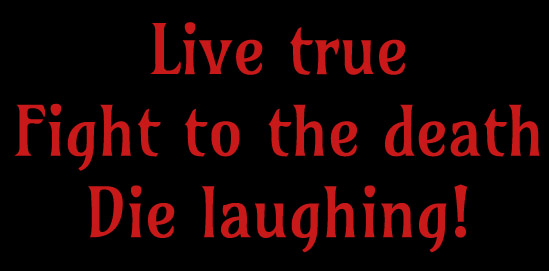
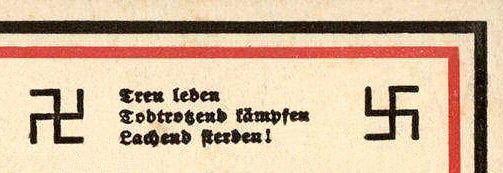
Scorned by hostile forces,
defeated by wild superior force,
Let us hold the symbol sacred,
which radiates like the sun through the night.
In the old days of our fathers it
was a symbol of becoming and of light,
so let us carry it in honor
to the terror of that dark creature.
As a feud symbol it should appear
against mammon's deceit and trickery,
and it should steel and unite
what is of German blood and thought.


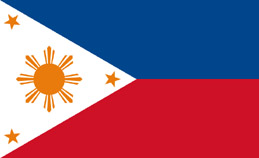


But it was the beginning of the end. Laurel had stalled and resisted the idea of declaring war on the Allies which, among other things, would have allowed Filipino troops to fight beside their Japanese allies. The declaration of war ended up being not much more than an empty gesture.


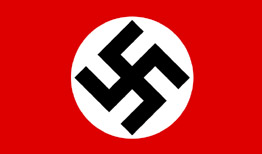

(Charles Dudley Warner, The Library of the World's Best Literature.
An Anthology in Thirty Volumes, 1917.)
(Charles Dudley Warner, et al., comp. The Library of the World's Best Literature.
An Anthology in Thirty Volumes. 1917.)
(C.D. Warner, The Library of the World's Best Literature.
An Anthology in Thirty Volumes, 1917.)
(Dithmarscher Landeszeitung, May 10, 1983)
Die Sandgräfin ('The Sand Countess', 1895)
Die drei Getreuen ('The Three Comrades', 1898)
Dorfpredigten ('Village Sermons', 1899-1902)
Das Heimatsfest ('The Home Festival', 1903)
Hilligenlei ('Holyland', 1905)
Peter Moor's Fahrt nach Süd-West ('Peter Moor's Journey to the Southwest', 1906)
Klaus Henrich Baas (1909)
The Loss of the Anna Hollmann (1911)
Sönke Erichsen, a play (1912)
Bismark (1914)
Die Brüder ('The Brother', 1918)
Der Pastor von Poggsee ('The Pastor of Poggsee', 1921)
Dummhans (1929)
Otto Babendiek ('The Anvil', autobiography)
Grübeleien ('Observations', 3 vols.)
Der brennende Baum ('The Burning Tree', 1931)
Recht oder Unrecht: Mein Land, a defense of Germany's actions in World War II ('Right or Wrong: My Country', 1940)


The term 'White Russian' has several interpretations. First, it stood in opposition to the Reds—the revolutionary Red Army who supported the Soviets and communism. Second, the word 'white' had monarchist associations: historically the first monarch of unified Russia, Ivan III, was styled 'Albus Rex', or 'white king'.





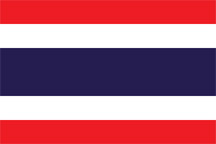






-Popular German saying
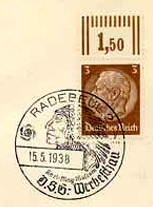


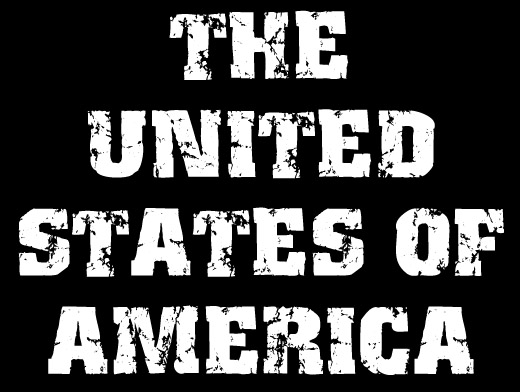
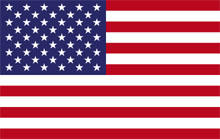


If you do not exclude them from the United States in the Constitution, in less than 200 years they will have swarmed here in such great numbers that they will dominate and devour the land, and change our form of government.
If you do not exclude them, in less than 200 years our descendants will be working in the fields to furnish them substance, while they will be in the counting houses rubbing their hands. I warn you, gentlemen, if you do not exclude the Jews for all time, your children will curse you in your graves. Jews, gentlemen, are Asiatics, let them be born where they will or how many generations they are away from Asia, they will never be otherwise.' (Chit-Chat Around the Table During Intermission by Charles Cotesworth Pinckney)





(And Despite All You Were Victorious!)


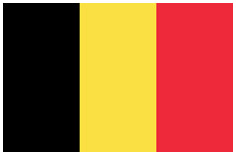
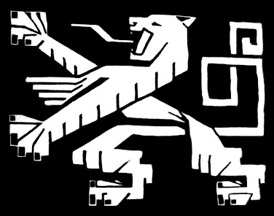

-Bert Deckers, May 16, 2012



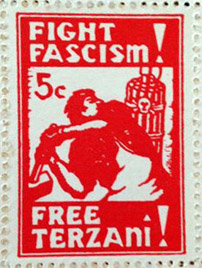



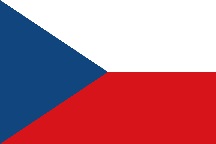








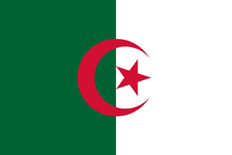







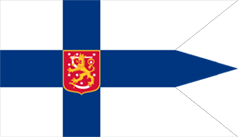

-Signal magazine, English edition.]








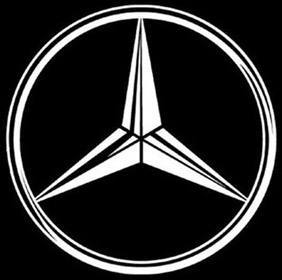



-|-
Third Reich Philatelia
-|-
-|-
Third Reich Ephemera
-|-
-|-
Third Reich Awards
-|-
-|-
Third Reich Miscellanea
-|-
-|-
Third Reich Identification Books
-|-
-|-
Third Reich Currency
-|-
-|-
The Great War
-|-
-|-
Hand of Pandora
-|-
-|-
Waffen-SS Technical Information -|-
-|-
The European Volunteer Movement in WWII -|-
-|-
Copyright -|-
